IS THE TENDENCY TO PSYCHOSOMATIC REACTIONS OUR REALITY?
#employee_ well-being
INTRAPRENEURSHIP: DRIVER FOR WELL-BEING IN ORGANIZATIONS? THEORY MEETS PRACTICE
DR. WIEBY ALTINK, UTRECHT UNIVERSITY SHOP
BUILDING A CULTURE OF CARE: HOW L&D CAN DRIVE WELL-BEING IN THE WORKPLACE

DR. MILANA MALEŠEV, FEFA
AMONG THE WORLD'S TOP DISEASES –DEPRESSION
SUZANA ĐORĐEVIĆ, HEMOFARM FOUNDATION
THE 4-DAY WEEK WORKS CHARLOTTE LOCKHARD 4 DAY WEEK GLOBAL
april 2023 No 09
H R W O RLD.OR G
SLOBODANKA CVETKOVIĆ PHILIP MORRIS SERBIA
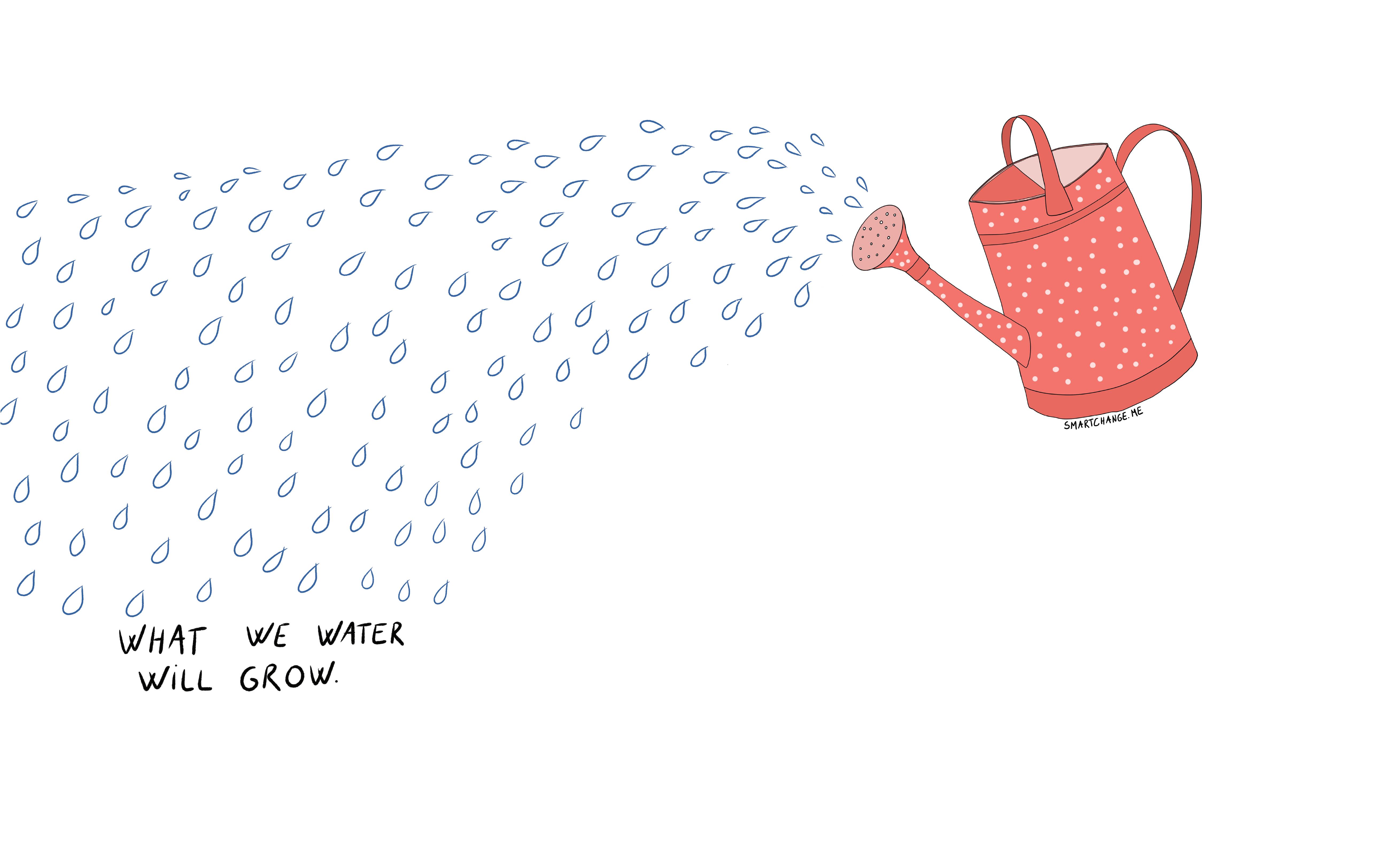

IMPRESSUM
EDITOR-IN-CHIEF
Nevena Stanisavljević
TOPIC OF THE ISSUE
Well-being
EDITOR
Tamara Jeremić
MANAGING EDITORS
Aleksandra Fuštić
Maša Vlahović
Almira Laličić
CONTRIBUTORS
Charlotte Lockhard, Alex Hirst, Lizzie Penny, Tom Haak, Jasmina Ridzi, Dr. Stefano Bianchini, Dennis Kaminsky, Nebojša Bjelotomić, Milica Helmih, Slobodanka Cvetković, Dr. Wieby Altink, Tijana Bejatović, Konstantina Marsenić, Steve Usher, Uroš Mitić...
CONTRIBUTING EDITORS & STAFF
Katarina Đorđević, Marija Todorović, Jovana Kostadinović, Nataša Leković, Nataša Timotijević, Slađana Trikić, Danica Ristić, Anđela Petronijević, Vlada Ranđelović, Katarina Ćirović
PHOTOGRAPHY
Unsplash, Freepik, Envato
COVER ILLUSTRATION
Jelena Marković, #smartchange.me
DESIGN
Belpak LLC, Željka Bašić Stankov Polovinas design studio
PRINT
Belpak LLC, Belgrade
2.000 copies
PUBLISHER HR WORLD LLC
PUBLICATION
Twice per year
Half year edition
CIP - Каталогизација у публикацији Народна библиотека Србије, Београд 005.96
HR World : better HR for a better world / glavna i odgovorna Editor-in-Chief Nevena Stanisavljević. - 2019, no. 1 (apr.)- . - Beograd : HR World, 2019- (Beograd : Caligraph). - 27 cm
ISSN 2620-2859 = HR World COBISS.SR-ID 276133644
2 | HR World 09 April 2023

06
WELL-BEING INTRAPRENEURSHIP: DRIVER FOR WELL-BEING IN ORGANIZATIONS?
THEORY MEETS PRACTICE
DR. WIEBY ALTINK, ORGANIZATION PSYCHOLOGIST/ LECTURER, UTRECHT UNIVERSITY SHOP
14
MENTAL HEALTH IS THE TENDENCY TO PSYCHOSOMATIC REACTIONS OUR REALITY?
SLOBODANKA CVETKOVIĆ, MANAGER EXECUTIVE SUCCESSION, PHILIP MORRIS SERBIA
24 TRENDS
THE 4-DAY WEEK WORKS CHARLOTTE LOCKHARD, CO-FOUNDER AND MANAGING DIRECTOR, 4 DAY WEEK GLOBAL
28
MENTAL HEALTH
AMONG THE WORLD’S TOP DISEASES –DEPRESSION
SUZANA ĐORĐEVIĆ, DIRECTOR OF HEMOFARM FOUNDATION, HEMOFARM
32 INTERVIEW
NENAD MIJAILOVIĆ
MSCF, CFA, ACCA, CFO, GALENIKA
34 TRENDS CLASSIC HR TRENDS YOU ALWAYS HAVE TO TAKE INTO ACCOUNT TOM HAAK, FOUNDER, HR TREND INSTITUTE
38
EMPLOYER BRANDING HOW AN EMPLOYER BRAND RESEARCH HELPED TO INCREASE REVENUES?
DENNIS KAMINSKY, PH.D. PARTNER AND FOUNDER, FUTURE TODAY
44
MENTAL HEALTH
WHEN EMPATHY AT THE WORKPLACE COMES WITH A HIGH PRICEWHAT IS COMPASSION FATIGUE?
ANDRÉ VAN KEMPEN, COO, BUJOO EDUCATION, VESNA LAKOVIĆ VAN KEMPEN, TRAINING SPECIALIST, BUJOO EDUCATION
50 TRENDS IS THIS TIME DIFFERENT? TECHNOLOGICAL REVOLUTION AND EMPLOYMENT
DR. STEFANO BIANCHINI, ASSOCIATE PROFESSOR, THE UNIVERSITY OF STRASBOURG
42 CULTURE CREATING A POSITIVE MENTAL HEALTH CULTURE - A MUCHNEEDED INTERVENTION GIGROUP
52 COMMUNICATION IS THE USE OF AI IN EVERYDAY LIFE OUR CLOSE FUTURE, OR JUST ANOTHER “BLACK MIRROR” EPISODE?
TIJANA BEJATOVIĆ, FOUNDER AND BUSINESS COMMUNICATION STRATEGIST, TOPIC
Content
56 EXPERIENCE
THE CANDIDATE AS CUSTOMER: HOW DESIGN THINKING CAN IMPROVE HIRING OUTCOMES
STEVE USHER, COFOUNDER, WONDER
70 TRENDS THE WORKSTYLE IMPACT ON MENTAL HEALTH AND WELLBEING, PRODUCTIVITY AND SOCIETY
ALEX HIRST, COFOUNDER, WORKSTYLE REVOLUTION, LIZZIE PENNY, CO-FOUNDER, WORKSTYLE REVOLUTION
75 DEVELOPMENT
BUILDING A CULTURE OF CARE: HOW L&D CAN DRIVE WELL-BEING IN THE WORKPLACE DR. MILANA
MALEŠEV, PHD A CIPD QUALIFICATIONS
TUTOR, FOUNDER OF LEARNING MAKEOVER, AND AN ASSOCIATE PROFESSOR OF SOCIAL AND ORGANIZATIONAL PSYCHOLOGY, FEFA
80
WELL-BEING
HOW VALUABLE IS A PERSON’S FIT TO THE ORGANIZATIONAL ENVIRONMENT AND DOES IT ENHANCE WELLBEING AND VITALITY?
MILICA HELMIH, PSYCHOLOGIST/ MASTER’S STUDENT, UTRECHT UNIVERSITY SHOP
86
WELL-BEING
PUTTING PEOPLE FIRST: HOW TO ADDRESS EMPLOYEE WELL-BEING?
JASMINA RIDZI, HRM CONSULTANT, FLEDGE WORKS
88
INTERVIEW
HR IN STARTUPS - WHO NEEDS IT?
NEBOJŠA BJELOTOMIĆ, CEO, DIGITAL SERBIA INITIATIVE
90
WELL-BEING THE NEW PARADIGM OF THE WORKPLACE – A WELL-BEING EXPERIENCE KONSTANTINA MARSENIĆ, DESIGN ARCHITECT AND FOUNDER, KONSTANTINA MARSENIĆ STUDIO AND WORK WELL
95
WELL – BEING | BEST PRACTICES
GENERGIJA – THE HEART OF A LION AND THE ART OF GOOD HEALTH!
JELENA VIŠNJIĆ, MANAGER FOR COMPENSATION & BENEFITS, STRATEGIC WORKFORCE
PLANNING AND HR ANALYTICS, GENERALI OSIGURANJE, SUZANA BANOVIĆ, TRAINING AND DEVELOPMENT MANAGER, GENERALI OSIGURANJE
96
WELL – BEING | BEST PRACTICES
WELL-BEING PROGRAMS –THE RIGHT THING TO DO IVANA VLAŠKI, LEARNING AND DEVELOPMENT EXPERT, CETIN
98 WELL – BEING | BEST PRACTICES
WORK-LIFE BALANCE IS THE KEY COMPONENT OF SUCCESS
BANCA INTESA
100 BEST PRACTICES MONTENEGRO HR COMMUNITY
103
DEI | BEST PRACTICES SCHNEIDER ELECTRIC
105 DEI | BEST PRACTICES ERSTE BANK
106
DEI | BEST PRACTICES NESTLÉ
Intrapreneurship: driver for well-being in organizations? Theory meets practice
6 | HR World 09 April 2023 WELL-BEING
Dr. Wieby M.M. Altink1 Organization Psychologist/Lecturer, Utrecht University SHOP
Nowadays organizations have to respond quickly and effectively to all kinds of challenges. The adagium is: ‘Don't wait, take action and change’. Studies on entrepreneurship teach us that entrepreneurs use their own talents and behaviors, and by doing so, also shape the work environment.
That’s often the reason why existing organizations are diligently looking for ‘intrapreneurs’: entrepreneurs within existing organizations.
(Antoncic & Hisrisch, 2003).
WELL-BEING April 2023 | HR World 09 7
1 Dr. Wieby M.M. Altink. Organization psychologist, The Netherlands. Lecturer and thesis supervisor at Utrecht University and Free University Amsterdam. HR consultant. https://www.linkedin.com/in/wieby-altink-talentmanagement/
Intrapreneurs are considered to be self-motivated, proactive, and action-oriented employees who have leadership skills and think outside the box. According to theory and academic studies, this concept works out at the organizational level, focusing on corporate entrepreneurship. Nevertheless, research concentrating on individual intrapreneurial employees is rare (Blanka, 2018), while it is often assumed that it would be beneficial for organizations when ‘the average employees’ also show (some) intrapreneurial behavior.
Is this the case, and is intrapreneurship also helpful and healthful for employees themselves?
Let’s look into what theory may provide us and examine and explain relationships between the concepts of intrapreneurship and well-being. We then try to put theory into practice by summarizing some findings from recent studies on this topic.
First, the relevance of well-being in organizations. Given the existing evidence linking employee well-being to key organizational outcomes such as performance and productivity, identifying ways to enhance employee well-being is, arguably, a core function of contemporary Human Resources (HR) professionals. There are, however, many more reasons to pay attention to employee well-being, and well-being goes further than the individual employee. As Kowalski and Loretto (2017, p.2249) indicate: “Employee well-being goes beyond the individual and the organization. Adopting a more holistic approach to well-being where a range of dimensions are addressed (for example, physical, mental, social and financial well-being) is a challenge for organizations, employees and HR professionals alike.” Despite this very true remark, we focus here on the specific concept of well-being at work. This concept is often related to situations and groups of employees who are less well-off. The point is then to study the characteristics of the jobs and organizations they work and increase, or, at least, consolidate wellbeing. Nevertheless, there are also large groups of employees who are not directly threatened by less well-being, but who do contribute a lot to the organization and also spend a long career in work. Well-being in the meaning of happiness and engagement at work is certainly
8 HR World 09 | April 2023 WELL-BEING
RESEARCH CONCENTRATING ON INDIVIDUAL INTRAPRENEURIAL EMPLOYEES IS RARE, WHILE IT IS OFTEN ASSUMED THAT IT WOULD BE BENEFICIAL FOR ORGANIZATIONS
WHEN ‘THE AVERAGE EMPLOYEES’ ALSO SHOW (SOME) INTRAPRENEURIAL BEHAVIOR.
IS THIS THE CASE, AND IS INTRAPRENEURSHIP ALSO HELPFUL AND HEALTHFUL FOR EMPLOYEES THEMSELVES?
relevant to them, and the demand for intrapreneurship often concerns these groups. The question is - do employees, who are prepared to dedicate themselves to the organization, initiate innovations, and undertake intrapreneurial actions, also benefit by experiencing happiness in their work?
First, a remark about well-being in organizations. What we now know from theory and research is that well-being has many definitions. A model that is well-known and quite often accepted within organizations is the tripartite model of subjective well-being of Diener (1984). This describes how people experience the quality of their lives and it includes both emotional reactions and cognitive judgments. It posits three distinct, but often related, components of well-being: frequent positive affect, infrequent n gative affect, and cognitive evaluations such as life satisfaction.
Since the research on well-being, also in the workplace, has increased, so have the definitions and measurements of this construct (e.g. Tov, 2018). Nowadays lots of measurement exists to examine well-being. In this article we will not dive into this complex but intriguing matter, but – simply because a lot of research has already been done into these concepts in the workplacetake general work satisfaction as the starting point for wellbeing at work. We focus on employees
April 2023 HR World 09 | 9 WELL-BEING
experiencing positive emotions, and feeling satisfied or engaged (Schaufeli & Salanova, 2014). With regard to this, a finding that evolves from studies in organizations is that a certain sense of control in work is positively related to wellbeing at the workplace (e.g. Humphrey, Nahrgang, Morgeson, 2007). The theory behind this is that control refers to one of the basic values/motivations in human life, as described by the social determination theory. According to this theory, three basic psychological needs motivate self-initiated behavior and specify essential nutrients for individual psychological health and wellbeing. These needs are said to be the universal and innate need for autonomy, competence, and relatedness (Ryan & Deci, 2000). Besides the possible positive outcomes for organizations, this brings in the idea that exerting control could also bring benefits to employees, like in intrapreneurial actions.
Control for employees at the workplace may have many origins. It can be located in the job, as a characteristic of the work (job control as part of the task), of the team (for example in an autonomous work group), in the management of processes (as for instance provided by participation in decision making), and as behavior displayed by employees. An example of the latter is out role behavior like the well-known Organizational Citizen Behavior: constructive employee actions and behaviors that aren't part of their formal job description. Actions that employees do, out of their own free will, support their colleagues and benefit the organization as a whole (Organ, 1997). Intrapreneurial behavior is less known in the context of employee control because intrapreneurs are considered to be crucial to deal with the challenges that organizations face today. This applies to the organization at the individual level (Blanka, 2018). At the level of employees, intrapreneurial behavior is defined as a voluntary and discretionary set of actions: proactivity, innovativeness, and risk-taking. From a broad psychological perspective, intrapreneurial behavior can be considered to be central to the theme of ‘adaptability in work organizations’, how people succeed to adapt to the changing environment at work (Chan, 2014). Intrapreneurial behaviors are linked to an increase in the development of new products, services, or ventures, leading to organizational innovation and renewal. Therefore, intrapreneurship is considered to be of strategic importance for organizations (Antoncic & Hisrisch, 2003). Is intrapreneurial behavior also providing employees with well-being at work? Based on the theory analysis, one would expect the answer to this question to be ‘yes’.
In an attempt to test the above notions and ideas in real life, students in the field of HRM and Organizational Psychology studied the topic of intrapreneurial behavior for their master thesis research. As a starting point, they considered the intrapreneurial
10 HR World 09 | April 2023 WELL-BEING
INTRAPRENEURIAL BEHAVIOR IS MEASURED IN SEVERAL SURVEYS WITH ONLINE SELF-RATING SCALES. SOME EXAMPLES OF QUESTIONS IN THIS MEASUREMENT INDICATE TO WHAT EXTENT YOU DO
THE FOLLOWING:
I FIND NEW WAYS TO DO THINGS (INNOVATION), I ACTIVELY FIX OR IMPROVE THINGS
I DON’T LIKE (PROACTIVITY), I DO THINGS THAT HAVE THE CHANCE OF NOT WORKING OUT (RISK-TAKING)
behavior of employees to be voluntary job behavior. Further, they treated it as a multidimensional behavior concept consisting of three main dimensions: innovation, proactivity, and taking risks. In addition, intrapreneurial behavior is measured in several surveys with online self-rating scales. Some examples of questions in this measurement - indicate to what extent you do the following: I find new ways to do things (innovation), I actively fix or improve things I don’t like (proactivity), I do things that have the chance of not working out (risk-taking). Some of the specific research questions in the various online surveys are: What are relevant antecedents of intrapreneurial behavior, which HR practices and task/organization factors influence this behavior, and what are relevant personal and contextual factors that work positively or negatively on the relations?
No overarching theory but various theories and models are used to shape the studies: Social Exchange Theory, Broaden and Build Theory, Self Determination Theory, Social Capital Theory, and Trait Activation Theory. In the various (different types of) surveys, a total number of 900 employees participated, coming from various organizations, working in several European countries, and belonging to several types of industries. So, the sample is quite heterogeneous. The main purpose is not to find exact findings to be generalized, but rather to explore basic notions about relationships between behaviors, situational factors, and outcomes in work. While, of course, no causal relations could be established in this type of research, some general findings emerged that can be considered to be in line with theory and previous research. First of all, it appeared that the intrapreneurial behaviors could be measured reliably, yielding evidence that the measurements operationalize the behaviors intended. In general, no significant differences were found for age groups, genders, or educational backgrounds. The surveys also revealed that intrapreneurial behaviors more or less follow a normal distribution: there are employees who indicate to prefer these behaviors to a great extent, average, or to a quite small extent. This seems to imply that there are meaningful individual differences to be demonstrated in intrapreneurship.
Trying to bridge the gap between theory and practice, we summarize the main findings of the research. These findings are derived by overviewing the outcomes of the several surveys at a qualitative level of results, trying to compose a comprehensive description of the findings of the individual studies. Positive relationships between intrapreneurial behavior are found with: Autonomy in work (the task gives room to undertake action),
Leadership (support of the organization and manager; Inclusive and human-oriented leadership), HR practices to promote social capital (information exchange and employee participation in work), Employee characteristics (Intrinsic motivation and selfefficacy: people have the idea that they can do it), Organization behaviors (external networking, Organizational Citizen Behavior) and Well-being (Engagement, Positive affect). No statistically significant relationships are found with Workload (the amount of work on the job), Reward strategies, Innovative climate in the organization (as indicated by the employee), and Individual Performance (self-rated by the employee). Of course, there are still many questions open, such as - is intrapreneurship similar to each organization, or field of industry? Does intrapreneurship always consist of the three behavior pillars - innovation, proactivity, and risk-taking? Also, there are many limitations to the studies and possible biases, for instance, the restricted samples.
Keeping these restrictions in mind, we observed a small direct effect between intrapreneurship and well-being: correlations in the range .15-.30, and in some studies, no significant correlations, the effect varying per sample/survey. In this instance, well-being relates to the hedonic type, feeling the work stimulating and pleasurable, or the commitment type of well-being, feeling part of the organization and feeling to be included. So, the correlation in this research is certainly not ‘strong’ and
April 2023 HR World 09 | 11 WELL-BEING
2 The findings referred to here come from 16 thesis students involved in 4 general survey studies, publicized in 2019-2022. For specific findings of these master thesis studies, please contact the author of the article.
INTRAPRENEURS ARE OFTEN FOUND IN ORGANIZATIONS THAT GIVE ROOM TO INITIATIVES, THAT ALLOW FOR EMPOWERING OF EMPLOYEES AND FOSTER PEOPLE AND TRANSFORMATIONAL TYPES OF LEADERSHIP STYLES
overwhelming, nor very consistent. Considering this finding on the direct relationship, it is not said that intrapreneurship does not foster well-being via other factors and processes. For instance, in our and other studies, intrapreneurs are often found in organizations that give room to initiatives, that allow for empowering of employees and foster people and transformational types of leadership styles. From a psychological point of view, this seems logical. Intrapreneurship asks for leaving the comfort zone and taking new actions and risks to ask for space to do this, as well as an interesting and praising attitude of the manager. The core question, perhaps, is: in what type of work environment intrapreneurial behavior thrives best, so it will bring joy and happiness to employees? Besides theory, also studies in organizational context are needed to obtain more insight
into this issue. This can be achieved by surveys as discussed here, but interview studies may provide relevant insights. Undoubtedly, HR is, by definition, an area where theory and practice meet each other, and can feed and add to each other.
What are the implications of all the above for HR in today’s organizations? It seems logical to assume that fostering intrapreneurial behavior in organizations could be a win-win for the organization and employee, but also there should be room to allow intrapreneurial actions. Otherwise, the research into this type of behavior and its relationship with indicators of well-being is quite young and findings indicate that the assumed associations are not that clear-cut. As stated, it may be that the work environment that surrounds the employee acts as a lever. For HR, there are many ways to intervene in this and to proactively influence relationships and behaviors. In addition, HR professionals are often at the starting point of practical examinations and surveys in organizations, implying that they may have an important role in providing answers to questions raised around the intrapreneurship of employees. In other words: fostering the supposed win-win of intrapreneurship for organizations and employees may ask for intrapreneurial behavior of HR.
LITERATURE
Antoncic, B., & Hisrich, R. D. (2003). Clarifying the intrapreneurship concept. Journal of Small Business and Enterprise Development, 10(1), 7-24. https://doi.org/10.1108/14626000310461187
Blanka, C. (2018). An individual-level perspective on intrapreneurship: a review and ways forward. Review of Managerial Science. Doi: 10.1007/rev-manag-sci-11846-018-0277-0
Chan, D. (Ed.) 2014. Individual adaptability to changes in work. New directions in research. New York: Routledge.
Diener, E. (1984). Subjective well-being. Psychological Bulletin. 95 (3), 542–575. doi:10.1037/00332909.95.3.542
Humphrey, S.E., Nahrgang, J. D. & Morgeson, F.P. (2007). Integrating motivational, social and contextual work design features: A meta-analytic summary and theoretical extension of the work design literature. Journal of Applied Psychology, 92, 1332-1356.
Kowalski, T.H.P. & Loretto, W. (2017). Introduction: Well-being and HRM in the changing workplace. The International Journal of Human Resource Management, 28 (16), 2229–2255. https:// doi.org/10.1080/09585192.2017.1345205
Organ, D. W. (1997). Organizational citizenship behavior: It's construct clean-up time. Human Performance, 10(2), 85–97. https://doi.org/10.1207/s15327043hup1002_2
Ryan, R. M.& Deci, E. L. (2000). Self-determination theory and the facilitation of intrinsic motivation, social development, and well-being. American Psychologist. 55 (1): 68–78. doi:10.1037/0003-066X.55.1.68
Schaufeli, W.B. & Salanova, M. (2014). Burnout, boredom and engagement in the workplace. In: An introduction to contemporary work psychology, 293-320. M.C.W. Peeters, J. de Jonge & T.W. Taris (Ed). Wiley & Sons.
Tov, W. (2018). Well-being concepts and components. In E. Diener, S. Oishi, & L. Tay (Eds.), Handbook of well-being. Salt Lake City, UT: DEF Publishers. DOI:nobascholar.com
WELL-BEING
12 | HR World 09 April 2023



ADRIATIC LUXURY Get to know the true essence of Adriatic comfort, surrounded by olive trees and vineyards overlooking the great blue Adriatic Sea. Visit Kempinski Hotel Adriatic in Istria, the fi rst Croatian 5-star golf & spa resort. +385 52 707 010 RESERVATION.ADRIATIC@KEMPINSKI.COM KEMPINSKI.COM/ISTRIA
IS THE TENDENCY TO PSYCHOSOMATIC REACTIONS OUR REALITY?
Slobodanka Cvetković, Manager Executive Succession, Philip Morris Serbia
14 | HR World 09 April 2023 MENTAL HEALTH
How often are you able to say that you have experienced stress reactions in your daily life? Some would say “rather rarely” (the lucky ones) while others would say “this is my daily reality”. Even though we know that there are some “positive” types of stress which might even enhance our productivity, we often experience “other” types, which may “hurt our body and soul”. With this, our quality of life might be decreased, and our energy levels minimized. Moreover, our health might be ruined, and we would enter the world of psychosomatic disorders and diseases.
April 2023 HR World 09 | 15 MENTAL HEALTH
There are plenty of symptoms recognized as psychosomatic disorders and diseases: migraine and tension headaches, hypertension, gastrointestinal disturbances, dermatitis, ulcers, anxiety, neurodermatitis, respiratory ailments… (Zotović, 2002; 2004). "Functional and structural disorders of human organ systems in which etiology, in addition to several other psychological factors, play a decisive role, are called psychosomatic disorders and diseases" (Zotović, 2002, p. 16). Will each stressful stimulus cause our stress reaction? Of course not. We differ depending on the way we respond to stress.
The way a person reacts to stress can be adaptive or lead to negative effects and maladaptive coping mechanisms. Successfully overcoming stressful situations requires adequate adaptation and depends on personality traits, acquired experience, body type predispositions, social support, and the general health condition of the organism (Nikolić and Žikić, 2013).
Insufficient subjective strength in overcoming chronic or acute stressful situations and existing objective difficulties cause anxiety and regressive adjustment mechanisms that can lead to psychosomatic disorders. It is considered that anxiety, aggressiveness, and depression are the emotions most often associated with the onset of psychosomatic diseases (Hadži-Pešić, 2009).
When asked about critical external factors that cause stress reactions, some would prioritize their personal lives, while others will put focus on their experience in a working environment. Of course, there is no strict split between our professional and personal lives as our personality echoes our overall experiences. Nevertheless, we wanted to get a better understanding of how people react in a working environment: will they experience a tendency to psychosomatic reaction as a maladaptive response to a stressful stimulus; will their different professional roles make a difference between them in their tendency to psychosomatic reaction, will their preferred leadership style make a difference between managers in the tendency to psychosomatic reactions, etc.
To reply to all these questions, we created a study in which we included more than 330 respondents from different working organizations and split them into two big groups based on their career stages – as Managers or those who are leading the teams (N=144) and Individual Contributors, i.e. those without managerial role (N=178).
For the measurement, we used a questionnaire of the tendency towards psychosomatic manifestation (HI) from the cybernetic battery of conative tests (KON 6), authored by Momirović, Wolf, and Džamonja, 1992.
16 | HR World 09 April 2023 MENTAL HEALTH
Table 1. Tendency towards psychosomatic reactions. Results:
enhance our employees to overcome stressful situations with more adaptive reactions. There is a huge area of the personal perspective of the discrepancy between the working requirements as stressful demands and the perception of their possibilities to overcome them.
The results we got are as follows: Once we compared our measurement with the norms (according to the manual KON 6, Momirović and associates) we realized that on the overall sample, as well as on the subgroup of Managers and the subgroup of Individual Contributors, the obtained results are mildly higher than the average. On the other side, there was no statistically significant difference in the tendency towards psychosomatic response between these two groups of respondents.
So, based on this research we could see that a moderate presence of this phenomenon really exists. Even though
the collected results were not very high, we should not reduce the importance of the close link between the psychosomatic reactions of the employees and their overall health conditions and well-being, on one side, as well as their productivity and organizational efficiency, on the other. Obviously, the use of psychosomatic as “the buzzword” in the modern world is not unjustified and over-emphasized. On the contrary, we should think about the potential factors that may cause such a condition, to prevent them timely, as intensive factors within the work environment. Of course, it would not be enough. We should think about how to
What we also saw was that the specific career stage of our respondents, Managerial level or Individual Contributor, did not prove to be a factor that would make a distinction in the degree of expression of the tendency towards psychosomatic response.
We also wanted to understand if the different tenures of the working experience will have an impact on the tendency to psychosomatic reactions. Based on the split we made (1st category: from 1 to 10 years of service and 2nd category: above 10 years), there was not a significant impact neither in the subsample of the Managers nor in the subsample of the Individual contributors. However, in both subgroups, in both tenure categories, we could see a tendency towards psychosomatic reactions mildly higher than the average, once compared with the norms.
And finally, the results showed that there was no statistically significant difference in the tendency towards psychosomatic response regarding the gender of the subjects; however, both males and females showed a tendency
towards psychosomatic reactions mildly higher than the average, once compared with the norms.
Psychological theories emphasize personality characteristics and the way we reply to stressful stimuli
April 2023 | HR World 09 17 MENTAL HEALTH
Programs for individuals’ enhancement should be personalized by taking into consideration different personalities needs and their way of reactions
Career stage N Mean SD Managers 144 58,76 18,98 Individual Contributors 178 60,13 20,34 Total 322 59,52 19,73 Norms 51,10
KON 6 – HI Tenure Mean SD t Ss Sig Psychosomatic 1.category 57.15 19.554 .710 141 > 0,05 2.category 59.47 18.614
Table 2. Difference in the tendency to psychosomatic reactions based on the tenure of the work experience – Managerial level
KON 6 – HI Tenure Mean SD t Ss Sig Psychosomatic 1. category 59.02 19.449 .840 173 > 0,05 2. category 61.64 21.358
Table 3. Difference in the tendency to psychosomatic reactions based on the tenure of the work experience – Individual Contirbutors
as critical in the etiology of psychosomatic disorders. Therefore, we wanted to explore further if there was a correlation between the tendency to psychosomatic reaction and personality, by using the Five-Factor Theory of Personality.
A Five-Factor Theory of Personality – FFM, also known as the Big Five Model (McCrae & Costa, 1992) has been used for defining personality traits; the measurements were performed by using the NEO PI-R personality questionnaire (Cvetković, 2016).
This model implies a hierarchical structure of personality traits. Personality traits are classified into five basic dimensions:
- N, Extraversion - E, Openness - O, Agreeableness – A, and Conscientiousness - C. The basic five factors are called domains and include groups of different cognitive, affective, and behavioral dimensions that can be grouped in different ways. Facets are narrow features that represent basic domains (Džamonja-Ignjatović, 1999; Knežević et al., 2004).
The domains are:
• Neuroticismdistinguishes adaptability and emotional stability from maladjustment and neuroticism; includes anxiety, angry hostility, depression, social discomfort, impulsiveness, and hypersensitivity.
• Extraversionconcerns the sociability of a person, and includes warmth, gregariousness, assertiveness, activity, the pursuit of excitement, and positive emotions.
• Openness to Experienceimplies aesthetic sensitivity, intellectual curiosity, preference for diversity, the need for change, and independence of thinking, i.e., the tendency to non-dogmatic attitudes; includes fantasy, aesthetics, feelings, actions, ideas, and values.
• Agreeablenessconcerns the interpersonal tendency of a person and encompasses trust, honesty, altruism, tolerance, modesty, and mild temper.
• Conscientiousnessimplies the ability to selfcontrol as a disciplined pursuit of goals and strict adherence to personal
principles; includes competence, order, duty, achievement, self-discipline, and thoughtfulness (Džamonja-Ignjatović, 1999; Stojiljković, 2014).
The results confirmed a statistically significant correlation between the tendency toward psychosomatic response and the following personality dimensions:
• High positive correlation with Neuroticism;
• Low negative correlation with Conscientiousness;
• Very low negative correlation with Extraversion;
• Very low negative correlation with Agreeableness. Thus, Neuroticism is the personality dimension that is the most important correlate of the tendency towards psychosomatic response, precisely because it involves anxiety, concerns, fear, and a tendency to experience anger, shame, sadness, and helplessness. On the other hand, Extraversion with positive emotions and a tendency to feel emotions
18 | HR World 09 | April 2023 MENTAL HEALTH
Neuroticism
KON 6 – HI Gender Mean SD t Ss Sig Psychosomatic Male 58.03 20.051 .506 142 > 0,05 Female 59.64 17.750
Table 4. Gender based difference in the tendecy to psychosomatic reactions – Managerial level
6 – HI Gender Mean SD t Ss Sig Psychosomatic Male 57.49 19.528 1.412 176 > 0,05 Female 61.88 20.773
Table 5. Gender based difference in the tendecy to psychosomatic reactions – Individual Contributors
KON
such as love, joy, and excitement, also expectedly negatively correlates with psychosomatic response. High sociability, warmth, cheerfulness, cordiality, spontaneity, and sociability certainly confirm the reverse association with psychosomatics. Also, in a reverse correlation with the tendency towards psychosomatic reaction is Agreeableness as a dimension of personality characterized by tolerance and mild temper, as well as Conscientiousness specified by competence, readiness to face life, and selfconfidence.
And finally, we wanted to understand if the different Leadership styles of our group of Managers will show the difference in their tendency to psychosomatic reactions. For defining the Leadership style we used the Fiedler Contingency Model. We
measured two different styles of leadership behavior by using a test called the Least Preferred Coworker (LPC) scale (Fiedler, 1967). Fiedler has defined two leadership styles – relationship-oriented and task-oriented leadership styles. However, which style is more effective will depend primarily on the situation in which the Lead is behaving. So, Fiedler starts from three situational factors that influence the choice of the most effective leadership style:
a) the relationship between the leader and the members, i.e. how attached the group members are to the leader, how ready they are to follow the Leader, then b) the structure of the tasks - i.e. whether it is about a routine, repetitive task or a complex and indefinite task, and c) the degree of power the Leader has; i.e. how many leaders can influence the team members. Whether a permissive or
a directive leadership style would be more effective will depend on the combination of the mentioned factors.
Therefore, in situations where the leader is accepted, the task is structured, and the leader has great influence, the most applied leadership is task-oriented leadership, and directive leadership. Namely, when the situation is extremely favorable, it is certainly not difficult for the team members to follow the received directives. Also, if the leader does not have a favorite place in the group when the task on which the group is working is unstructured and the leader has little influence on his members, the leader should be directive and focused on the task.
In extremely difficult situations, no one expects special care to be taken about interpersonal relations, but
April 2023 HR World 09 | 19 MENTAL HEALTH
Neuroticism Extraversion Openness Agreeableness Conscientiousness Psychosomatic r .586 -.197 -.100 -.157 -.324 p < 0,05 < 0,05 .067 < 0,05 < 0,05
Table 6. Correlation between Tendency to psycosomatic reactions and personality dimentions
we created a study in which we included more than 330 respondents from different working organizations and split them into two big groups based on their career stages – as Managers and Individual Contributors
precisely about the solution of the task itself, i.e., the execution of the work. In moderately favorable situations, such as when the task is not structured but the leader is accepted or vice versa, Fiedler believes that the most effective leadership is one that focuses on relationships (Fiedler, 1967; Bojanović I Čizmić, 1997; Marković, 2006).
The results of our study showed that 44.9% of Managers prefer a nondirective type of leadership, i.e., that they have an understanding of their team members, are tolerant and that they accept others despite their areas for improvement.
A significant number of Managers, 40.1% of them,
showed that they prefer the directive type of leadership, i.e., that they are demanding, that they like to control, and that how people work is more important to them than how they feel. Also, 15% of Managers showed moderate expression of both styles.
When analyzing differences between managers with different leadership styles in relation to the degree of expression of the basic measured variables, both the tendency towards psychosomatic response and personality dimensions, no statistically significant difference was found.
Of course, it would be quite interesting to measure the
tendency to psychosomatic reactions of the employees which Managers showed different leadership stylesas an idea for some further surveys. Therefore, we may summarize our results as a confirmation that the tendency towards psychosomatic reactions really exists in the reality of our tested employees. Such tendency does not depend on the level of the career stage which they are in (either as Managers or Individual Contributors). In the case of Managerial roles, their different leadership styles (“task-oriented” or “peopleoriented”, in line with the Fiedler Contingency Model) will not make a difference in their tendency towards psychosomatic reactions. And finally, neither working experience tenure nor gender will make a difference in the tendency for psychosomatic reactions. Such analytics should be taken into consideration when we think about prevention and defining the organizational factors that may impact or cause the tendency toward psychosomatic reactions of our employees.
Also, results showed that some of our personal characteristics (Neuroticism, Conscientiousness, Extraversion, and Agreeableness in line with the Big Five Personality Theory) correlate with our tendency to psychosomatic
reactions, which we should take into consideration when we think about the prevention and creation of different programs for individuals’ enhancement. They should be personalized by taking into consideration different personalities' needs and their way of reacting. Such an approach will make a difference and support our employees in their own creation of healthy & successful lives.
REFERENCES:
Bojanović, R. i Čizmić, S. (1997). Shvatanja o ljudskoj prirodi i izbor stilova rukovođenja, Psihologija, 3, 169-180
Cvetković, S., (2016). Sindrom sagorevanja, psihosomatsko reagovanje, motivacija za postignućem i dimenzije ličnosti kod zaposlenih na rukovodećim i nerukovodećim radnim mestima. Doktroska disertacija, Niš: Filozofski fakultet.
Džamonja-Ignjatović, T. (1999). Psihodijagnostika i savremeni modeli ličnosti. Beograd: Zadužbina Andrejević.
Hadži-Pešić, M. (2009). Psihološki aspekti koronarne bolesti srca. Niš: Filozofski fakultet.
Fiedler, F. E. (1967). A Theory of Leadership Effectiveness. New York: McGraw Hill.
Knežević, G., Džamonja-Ignjatović, T. i Đurić-Jočić, D. (2004). Petofaktorski model ličnosti. Beograd: Centar za primenjenu psihologiju.
Marković, Z. (2006). Profil ličnosti rukovodioca i preferencije stila rukovođenja i odlučivanja. Doktorska disertacija, Niš: Filozofski fakultet.
Momirović, K., Wolf, B. i Džamonja, Z. (1992). KON 6 Kibernetička baterija konativnih testova. Beograd: Savez društva psihologa Srbije - Centar za primenjenu psihologiju.
Nikolić, G. i Žikić, O. (2013). Ličnost, prilagođavanje i stresne reakcije. U Pojedinac, porodica, društvo u tranziciji, Međunarodni tematski zbornik. Kosovska Mitrovica: Univerzitet u Prištini, Filizofski fakultet.
Stojiljković, S. (2014). Psihološke karakteristike nastavnika. Niš: Filozofski fakultet.
Zotović, M. (2002). Stres i posledice stresa: Prikaz transakcionističkog modela. Psihologija, Vol. 35 (1-2), 3-23.
Zotović, M. (2004). Prevladavanje stresa: konceptualna i teorijska pitanja sa stanovišta transakcionističke teorije. Psihologija, Vol. 37 (1), 5-32.
20 | HR World 09 April 2023 MENTAL HEALTH
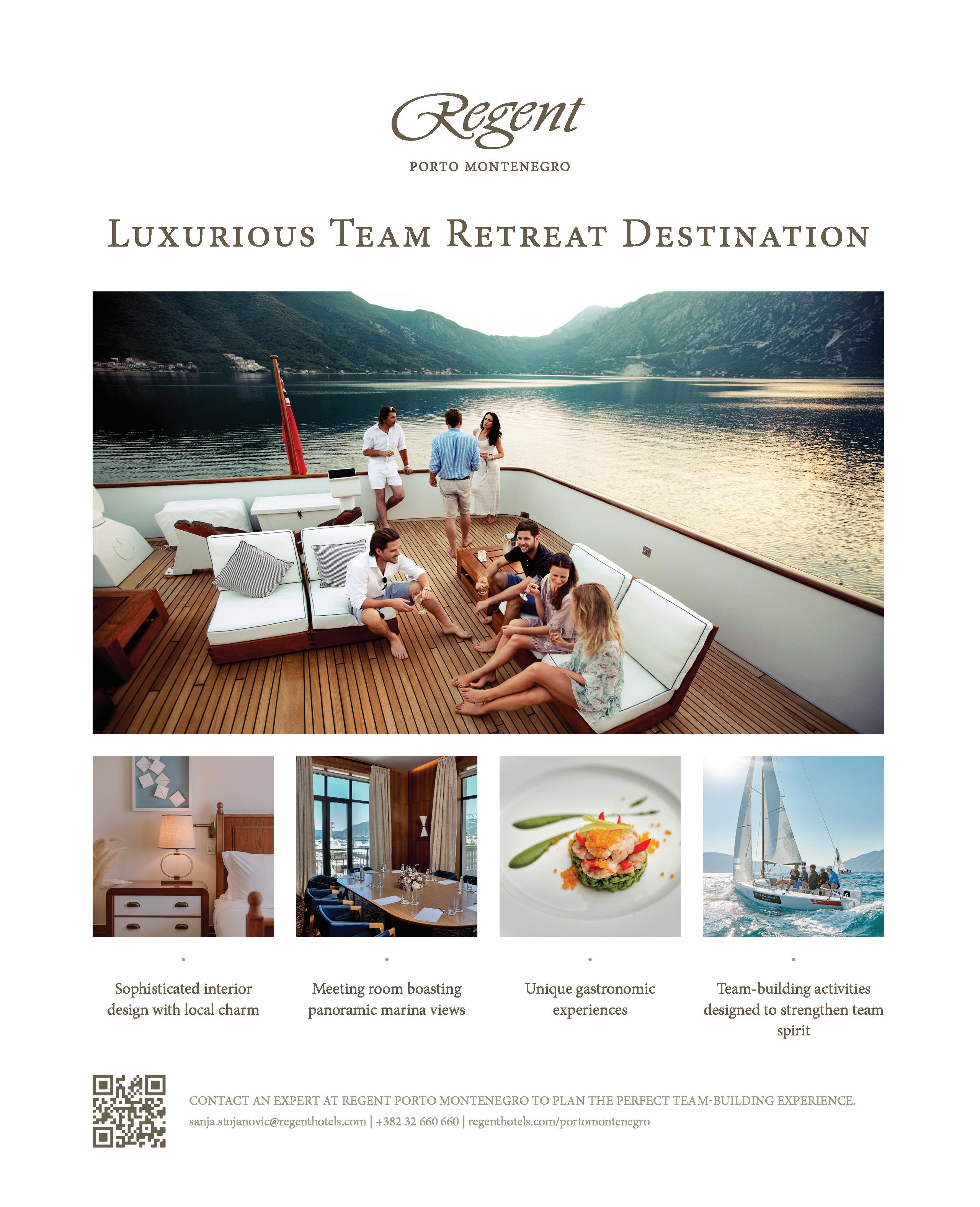
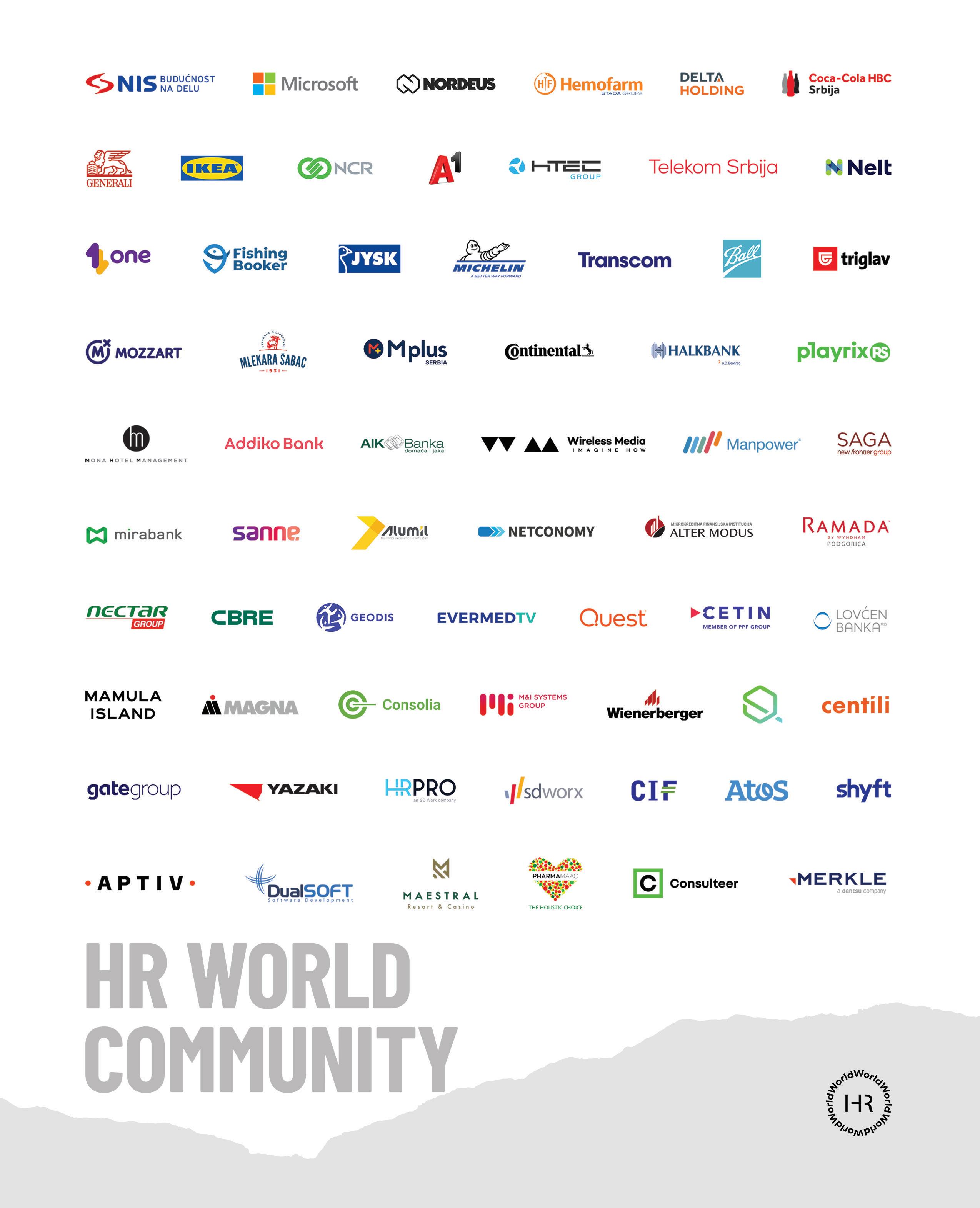
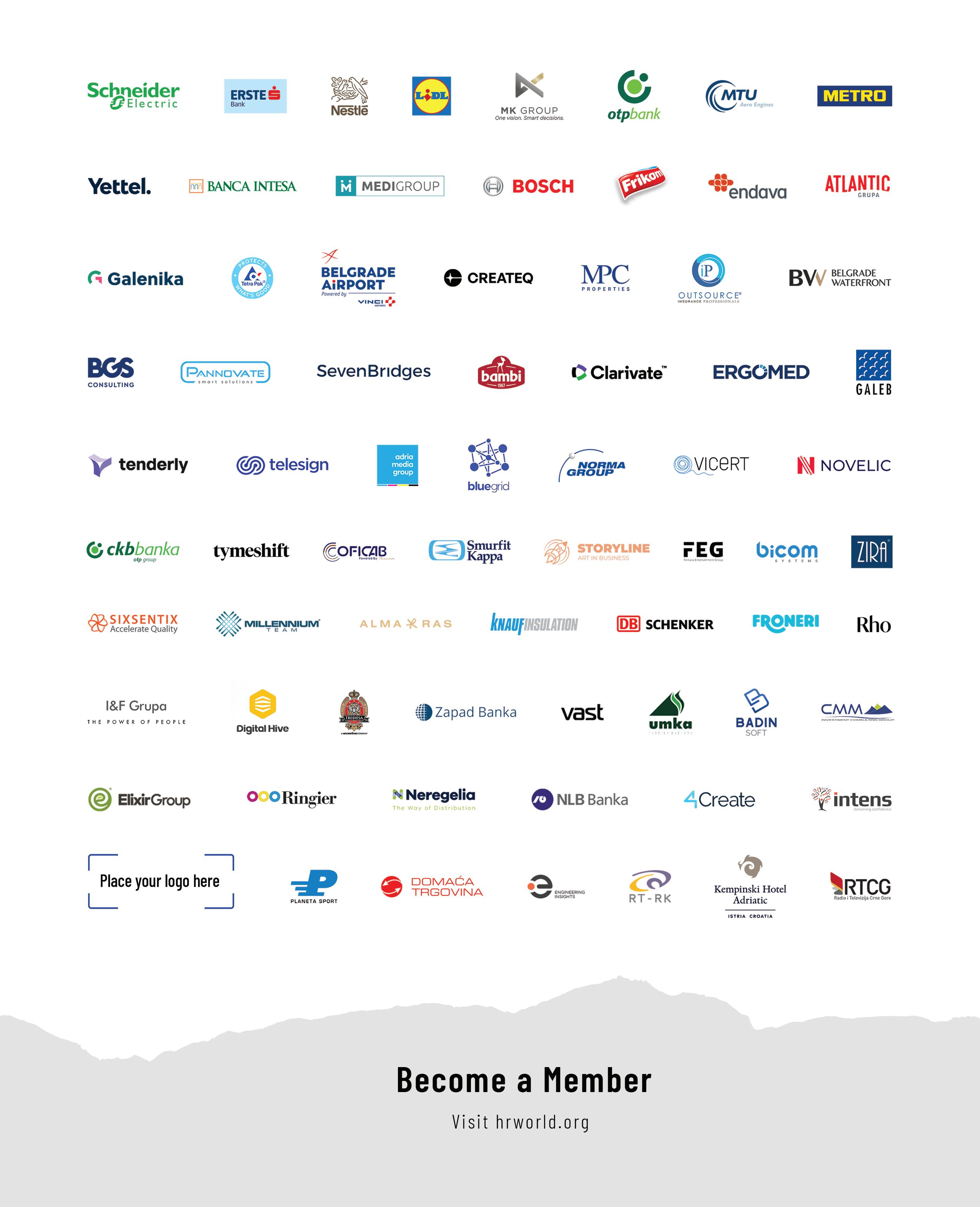
THE 4-DAY WEEK WORKS
24 HR World 09 | April 2023 TRENDS
Charlotte Lockhard, Co-Founder and Managing Director, 4 Day Week Global
When people hear about the 4-day week, they often wonder “What’s the catch?” A pay cut? Squeezing 40 hours into four days? Working at a higher speed to achieve the same level of output? Not with our 4-day week.
The flexible model of reduced work time we advocate for at the 4 Day Week Global is based on the general principle of 100:80:100™, pioneered by myself and our Co-founder Andrew Barnes in the landmark Perpetual Guardian trial in New Zealand, in 2018. That’s 100% of the pay, for 80% of the time, in exchange for a commitment to delivering 100% of the output.
Some companies will choose the traditional 32-hour/4-day week with a set day off; some may adjust rosters and shifts to achieve the same level of coverage and service throughout the workweek; and for some businesses, it might mean five shorter days.
But almost all companies that move to a 4-day week do three big things:
• radically shorten and reform meetings • use technology more thoughtfully and mindfully
• redesign the workday to build in distinct periods for focused work, meetings, and social time.
Studies show that the average worker actually loses two to three hours each day to useless meetings, poor technology implementations, and just plain old distractions. So the 4-day week is already here, we just can’t see it because it’s buried underneath these outdated practices. And now we have the proof.
NEW EVIDENCE FROM THE UK
In February, we released the results of the world’s largest pilot program of a 4-day week (4dayweek.com), which we ran in partnership with the UK’s 4 Day Week Campaign and think tank Autonomy. Sixty-one companies and almost 3,000 workers embarked on a six-month trial of a 4-day week in 2022 and, by all accounts, it was a resounding success.
THINGS:
- RADICALLY SHORTEN AND REFORM MEETINGS
- USE TECHNOLOGY MORE THOUGHTFULLY AND MINDFULLY
- REDESIGN THE WORKDAY TO BUILD IN DISTINCT PERIODS FOR FOCUSED WORK, MEETINGS, AND SOCIAL TIME
April 2023 | HR World 09 25 TRENDS
ALMOST ALL COMPANIES THAT MOVE TO A 4-DAY WEEK DO THREE BIG
The research – conducted by a world-class team of academics at Boston College and Cambridge University – found that almost every company (92%) decided to continue with the 4-day week after the pilot. The vast majority were satisfied that business performance and productivity were maintained, with revenue increasing by 1.4% on average throughout the trial and by 35% in comparison with a similar period the previous year.
Paul Oliver, Chief Operating Officer at one participating organization, Citizens Advice Gateshead, said the charity was keen on the idea of a 4-day week as a way of improving job recruitment and retention.
“We wanted a way of delivering services that ensured our clients were getting the best level of support from well-rested and more productive staff and the 4-day week was a game changer for us in that respect. In the months following the launch of the trial, our sickness levels went down and staff retention levels went up, bucking the trend shown by other similar organizations recently,” he said.
Paul’s company’s experience was largely mirrored across the other businesses on the trial, as research found the likelihood of an employee quitting dropped by a whopping 57%, resulting in a dramatic improvement in job retention. There was also a 65% reduction in the number of sick days taken across the entire cohort.
The employee outcomes are equally compelling, with staff reporting a 71% reduction in levels of burnout, a 39% reduction in levels of stress, and a 46% reduction in levels of fatigue. 73% of people recorded feeling greater satisfaction with their time, as well as measures of physical and mental health improvement.
THE GLOBAL OUTLOOK
This new research from the UK comes hot on the heels of our very first pilot program results – released last November – with data from the US, Ireland, and elsewhere. This brings to a total of 91 companies and roughly 3,500 workers who’ve completed our trials. Lead researcher, Professor Juliet Schor and her team at Boston College combined all of this information to give a global overview of how the 4-day week is working.
Unsurprisingly, business and worker outcomes are largely the same, indicating that this is a universally beneficial policy. They also observed some interesting statistics
26 HR World 09 | April 2023 TRENDS
STUDIES SHOW THAT THE AVERAGE WORKER ACTUALLY LOSES TWO TO THREE HOURS EACH DAY TO USELESS MEETINGS, POOR TECHNOLOGY IMPLEMENTATIONS, AND JUST PLAIN OLD DISTRACTIONS
THE EMPLOYEE OUTCOMES ARE EQUALLY COMPELLING, WITH STAFF REPORTING A 71% REDUCTION IN LEVELS OF BURNOUT, A 39% REDUCTION IN LEVELS OF STRESS, AND A 46% REDUCTION IN LEVELS OF FATIGUE. 73% OF PEOPLE RECORDED FEELING GREATER SATISFACTION WITH THEIR TIME, AS WELL AS MEASURES OF PHYSICAL AND MENTAL HEALTH IMPROVEMENT
THE RESEARCH –CONDUCTED BY A WORLD-CLASS TEAM OF ACADEMICS AT BOSTON COLLEGE AND CAMBRIDGE UNIVERSITY – FOUND THAT ALMOST EVERY COMPANY (92%) DECIDED TO CONTINUE WITH THE 4-DAY WEEK AFTER THE PILOT
on gender. While both men and women have improved outcomes on a 4-day week, women are generally greater.This is the case for burnout, life and job satisfaction, mental health, and reduced commuting. Men are also taking on a bit more of their share of housework, and even more childcare.
There were also some positive findings concerning the environment, with commuting time falling by a half hour per week across the full sample.
Finally – and reassuringly – people are not using their extra day off to take on paid work elsewhere. Instead, they are using it for hobbies and leisure, housework and caring, and personal maintenance.
Emilie Cobbold, Program and Administration Coordinator at Our
Community in Australia, is representative of many workers on a 4-day week.
“Come Friday, I have all the time in the world to do my life admin while nourishing my physical, mental, and spiritual self. I work out; I catch up with my loved ones; I volunteer at my community chicken coop; I see my therapist; I go bushwalking; I read; Sometimes I even nap. In simpler terms, I am a better person to be around,” she said.
TRIAL A 4-DAY WEEK IN YOUR BUSINESS
This research proves what we already knew to be true – that the 4-day week works. Now it’s time for others to get on board. The best way to do this is by running a trial in your organization for a set period of time. To start, be very clear about what success looks like and give your employees an appropriate amount of time to prepare and plan how they will best succeed under this new program. This should be a collaborative effort and not managed from the top, down.
As you run your trial, be prepared to adapt and change based on what you learn about your organization. Provide regular engagement opportunities for management and employees to learn from each other too. Then, once your trial has concluded, compile and review your results and proceed accordingly.
Many companies have successfully attempted this themselves but for expert assistance, we have tiered packages of support available to assist you with this transition, developed using real-life experiences from a variety of businesses all over the world. Dare to be bold and explore the opportunities that this new work model can bring to your company.
REFERENCES:
UK pilot results and global overview: https://www.4dayweek. com/uk-pilot-results
US and Irish pilot results: https://www.4dayweek.com/ us-ireland-results
Pilot a 4 day week in your business: https://www.4dayweek.com/ pilot-program
Feel inspired and need more information on a 4-day work week? Visit www.4dayweek.com

AMONG THE WORLD'S TOP DISEASES
28 | HR World 09 April 2023 MENTAL HEALTH
Suzana Đorđević, Director of Hemofarm Foundation, Hemofarm
Even if there was a dilemma as to whether depression is among the top diseases in the world, it was eliminated by the World Health Organization when, on World Mental Health Day 2022, it appealed to heads of state and governments to make the care of people's mental health a global priority.
DEPRESSION
The COVID crisis has increased anxiety and depression by 25% and led to almost a billion people on the planet suffering from this disease. Every sixth adult resident of Serbia has met the criteria for some of the most common psychiatric disorders, and 80,000 more people than before experienced moderate depressive disorders during the coronavirus pandemic (survey on the nation's mental health during the pandemic, ‘Cov2Soul’). The war in Ukraine, accompanied by the energy crisis and inflation, imposed additional pressure. Anxiety and stress are on the rise also due to additional loss of control over life – a devastating earthquake that struck Turkey and Syria, took more than 40,000 lives, and the ground has not calmed down for days.
DIVIDED SOCIETY, ECONOMIC CRISIS, AND FALSE EMPATHY ARE DEVASTATING TO PEOPLE'S HEALTH
Living in a divided society, economic crises and false empathy are always devastating to people’s health. The effects of such life are reflected in an increased demand for psycho-social support that is very hard to receive, as the professionals – psychologists and psychiatrists – are overloaded with work. The data that worries refers to a survey of the organization PIN (Psychosocial Innovation Network), ‘Mental Health in Serbia: Assessment of Needs, Risk Factors and Barriers in Receiving Professional Support’, which indicates that only four psychologists are available per 100,000 people in Serbia.
EMPATHY AND SOLIDARITY ARE KEY TO FIGHTING DEPRESSION
Depression does not choose its victims. It does not necessarily come as a reaction to a particular event, tragedy, or personal loss. It can be triggered by no apparent reason, and it can happen to everyone regardless of gender, age, nationality, religion, or social status. Depression does not have odor, taste, or color and is not always characterized by a sad and tear-stained face.
When depression sets in, it breaks everything in front of it. It breaks desires, it breaks a heart, it breaks a home, it breaks a life. In order to be able to resist it, we must keep “a glimmer of motivation” and develop feelings of empathy and solidarity, and learn to listen, understand, and not reprimand.
April 2023 | HR World 09 29 MENTAL HEALTH
Depression does not choose its victims. It does not necessarily come as a reaction to a particular event, tragedy, or personal loss. It can be triggered by no apparent reason, and it can happen to everyone
RECOGNIZING LONELINESS AS ONE OF THE LEADING PROBLEMS THAT MODERN SOCIETY HAS BEEN FACING
At the time of the COVID crisis, Japan established the Ministry of Loneliness, seeing young people as the category of society where loneliness is most pronounced. Back in 2016, the United Arab Emirates (UAE) set up the Ministry of Happiness aimed at integrating happiness into policies, programs, and services of all state bodies and promoting well-being and happiness as a lifestyle in the community. Looking up to Japan and UAE, Serbia could also consider establishing a People’s Well-being Office, where the business sector could also join in. The data from a McKinsey Health Institute publication suggest that being satisfied at work and business engagement are correlated with the feeling of involvement and support, elimination of toxic behavior, pressure from workload, and freedom from stigma. That’s why this kind of support, through establishing, for example, the Employees’ Well-being Division, is important for creating employees’ satisfaction with the environment in which they spend at least 8 hours a day.
HOW TO RECOGNIZE DEPRESSION
Depression is not only a sad and tear-stained face, as already stated. It can hide behind the smile of people who appear to have a good time, whose photos on social networks, such as Instagram, suggest a beautiful and fulfilled life.
SO, WHAT ARE THE SYMPTOMS TO LOOK OUT FOR?
If your usual sleeping routine has been disrupted (you can't fall asleep, wake up every hour or wake up with difficulty, your sleep does not make you feel refreshed, you either have nightmares that don't stop or don’t have dreams at all), you have problems with concentration because you constantly think about certain issues and
problems, when you can't read, study or work... It’s high time to do something about it. Depression is most often accompanied by a feeling of lower personal worth, loss of self-esteem, loss of faith in one's abilities, inability to contribute to family or society, and loss of hope that anyone cares for you. Feelings of sadness, helplessness, loneliness, social isolation, loss of will to do anything, to enjoy anything, and to feel satisfaction are also there.
The most important thing is not to ignore these signals, not to ignore depression, not to hide it and not to be ashamed of it. Talk about your feelings with your loved ones and seek professional help.
THE HARDEST THING IS GETTING STARTED
Going out for a walk, staying outdoors, or doing sports is a good way to tackle depression and not give up on yourself. Think about what makes you happy – caring for others, caring for pets, caring for plants, faith, art, a hobby... and indulge in that pleasure. It can be healing. Family, a partner, and friends, as well as being a part of larger groups – self-help groups, singing in a choir, team sports, and humanitarian work, can be a significant source of support. Friendships are precious, especially with people who have had a similar experience and with whom you can talk openly about how you feel and what you are going through. If you don’t get support from your family and friends, seek professional help. It is important to react instantly. In addition to professional support, the way out of the crisis is also enhanced by medicines, physical activity, socializing, and hobbies.
TALK ABOUT HOW YOU FEEL
For 30 years already, Hemofarm Foundation has been raising topics important for our society – they are not always pleasant but are important for the well-being of all of us. Intending to have mental health treated in the same way as physical health, in 2019 Hemofarm Foundation launched the project ‘A Cup of Coffee with a Psychologist’, in which, with the support of experts, we openly discuss topics that are not always pleasant but are necessary, have a red alarm status and require the engagement of the entire community.
If you are going through a mental health crisis and need professional help and support, call the SOS line for fighting depression and stigma at 0800 001 002 (for Serbia) or send an e-mail to podrska@nesalomivi. rs. The SOS line was established by Hemofarm Foundation within the project for fighting depression and stigma, called ‘Unbreakable’. The experts (psychologists and psychiatrists) from four Special hospitals for psychiatrist diseases in Vršac, Gornja Toponica, Kovin, and Novi Kneževac have been working on the SOS line. Over the course of two years of the project implementation, more than 15,000 people received support, and messages of gratitude arrived on a daily basis. The help and support are free of charge, anonymous, and available 24/7.
30 HR World 09 | April 2023 MENTAL HEALTH

Nenad MIJAILOVIĆ
We tend to identify our business achievements through the results of the organization we belong to.

It may be a flawed approach because the difference between our effort, conduct, professional and ethical judgment, and its materialization in the form of the result of the company we work for, may be pure luck or lack of it.
Nevertheless, it may happen that personal effort and the result of the organization
converge in success. I was fortunate enough to experience it more than once in my professional career, and the last of these fortunate events was the restructuring of the company I am currently employed with as CFO, a pharmaceutical producer from Serbia – Galenika.
Just 5 and half years ago it was a beleaguered, former behemoth and leader of the former Yugoslavia, with too much past, depressing present, and bleak future. It took the new owner and new management team 5 and half years to turn it into the fastest-growing, second biggest player in the local market with a Revenue CAGR of 25% in the said period.
Building on the strong brand, institutional
32 HR World 09 | April 2023 INTERVIEW
1
C-level
A BUSINESS ACHIEVEMENT YOU ARE PROUD OF
spotlight interview
MsCF, CFA, ACCA, CFO, Galenika
knowledge and commitment to quality of the old, by adding value-based management, customer focus and result-driven culture of the new, resulted in the Goldilocks’ mix that has proven to be just right for the given circumstances.
I played my fair share in this fruitful exercise and that is what I have been proud of lately.
2
HOW TO SURVIVE IN THE NEW BUSINESS ENVIRONMENT
Stick to the fundamentals. Whatever strategies you employ, the path you choose, the ball game should be the same. Long-term ability to generate revenue growth and a high enough return on the invested capital (relative to the cost of capital) should do the job. Once we sort this out, we may engage ourselves in a more intellectually inspiring discussion about stakeholder vs shareholder values.
THE HR FUNCTION IN 2030
Start from the big picture, fundamentals mentioned previously and drive it down to the roots. Be aware of all constraints you have to work around (tight labor markets, talent deficit, millennials’ self-awareness and craving for work-life balance, wage inflation) and populate your companies with the right people highly motivated and unambiguously directed towards the same goal.
3 4
MESSAGE FOR HR DIRECTORS IN THE REGION
Sooner rather than later, you will be tapping into the same pool of talents among yourselves. A more mobile labor force will push you to be more competitive and more alert to what your colleagues in the region are doing.
THE MOST CREATIVE JOINT ACTION WITH EMPLOYEES
Being creative as a CFO does not necessarily resonate too well. Acting with integrity, objectivity, professional competence and due care will do the job instead. We leave the creativity for our teambuilding events. Work hard, play hard. ;)
5 6
BEST CONFERENCE YOU HAVE BEEN TO
Nassim Taleb’s take on optionality and antifragility at Mubadala’s investment conference organized on the eve of Formula 1 Abu Dhabi Grand Prix.
THE
LAST BOOK YOU READ
THE TREND THAT IS CONQUERING THE WORLD
7 8
In pop culture - easy to digest, short and superficial forms.
In politics - divergence in policies, ideological rifts driven by group identities.
In Business - subscriber (recurring) revenue-based models, empowered by big data analytics and resulting in benefits from network effects for its users. Unfortunately, very unlikely to decouple from the trends in pop culture and politics.
April 2023 HR World 09 | 33 INTERVIEW
Tim Marshall’s The Power of Geography.
Classic HR trends you always have to take into account
Tom Haak, Founder, HR Trend Institute
34 | HR World 09 | April 2023 TRENDS
Don’t forget about the fundamentals of a human approach. Often, it’s not about the trends, it's about how we treat people. We need to know what people want and expect. They want basic things like respect, to be heard, a boss that recognizes them, a nice challenging job, and to work in a pleasant team.
Many of the HR trends are not changing so rapidly, many of the trends have been around for years and years and then the question is - why are we, as HRs, so slow in adopting these trends?
(extroverts/introverts)... Only after this, we can craft workplace solutions around it.
beings are working. In HR it can be used to overcome any biases.
HERE ARE THE 5 CLASSIC TRENDS:
Personalization - It is a long-term but super difficult trend for people in HR. The first thing about personalization is to take the individual needs, wishes, preferences, and capabilities of people into account. There’s a constant push to standardization and one-size-fits-all, and “Everybody has to do this”... We’ve seen a lot of these examples during COVID, not personalization but standardization. To apply personalization we need to look at the work people are doing, the home situation (for some it’s very hard to work from home), the personality of employees
Speed - Everything goes faster and faster. However, many HR practices are still so slow. Why? For many candidates, it takes a lot of time to apply to companies’ jobs, and then for companies to schedule interviews, and give feedback to candidates... The Performance Management cycle and pay cycle are also slow, and companies must learn how to improve the speed of these processes.
1 3 4 5 2
Technology (Automation and Augmentation) - Technology is fueling a lot of possibilities. This trend is connected to personalization and speed because it can help a lot with personalization and speeding things up. Automation helps things be done much quicker and better. Augmentation helps to understand how to use technology to improve the way human
Purpose - Not only the purpose of organizations but the purpose of people. It’s not only about working for the money but having an answer to “Am I really able to make a difference in the world, with my employer?” Purposes must be real and not artificial. What we should watch out for are the Anti-work movement and Quiet Quitting
Employee experience - Employees are expecting a real experience - How can we make work fun and a positive experience? The expectations of people are different. Not everybody expects the same experience, so we must look at different groups of different people and see how we can create and design an experience that fits with different people in the organization.
April 2023 HR World 09 | 35 TRENDS
9 NEW TRENDS FORECASTED FOR 2023 FROM THE HR TREND INSTITUTE
are not knowledge workers and HRs have to make a shift and give enough attention to non-knowledge workers as well.
people are, what the people want...A very interesting trend that has a lot to do with analytics.
“BREAKING BOUNDARIES”
1 3
People support in response to the crisis - How to support and help people in the period of crisis? People have expectations that organizations will help them. They often give people material support, financial support, or reduce the pay cycle.
The return of the unions - In recent years, we have seen an increase in unions, union action, union support, and traditional unionized industries. Employees are organizing themselves not only by discussing working conditions, but also the ethical purpose of the company.
Knowledge workers are not the center of the universe - There are many people who
The productivity puzzle - We’ve seen investments in technology, employee experience, L&D...but the productivity is stalling, it’s not growing very fast anymore. We should expect productivity to boost so it is important to look at the productivity puzzle and see where the problem is.
Virtual reality makes the metaverse a workplace reality - Virtual reality is an integral part of the metaverse, and that’s a good stepping stone for HR. See how you can use VR as your stepping stone into the metaverse.
4 7 5 8 6 9 2
Talent Intelligence Bureau - Organizations are increasingly installing a kind of TIB. It is looking at where the skills are, where the
Agile HR roles are crucial - More new agile HR roles are emerging, and they are becoming increasingly important.
Time to tackle the M-taboos - The “M” stands for menstruation and menopause. This is still a taboo in many organizations. The proportion of women over 50 in the workforce is growing, and many of them deal with this kind of problem, find it difficult to discuss it, and find work not understanding enough. It is time to tackle this taboo.
Net - 0 is priority No. 1 - This is important both for organizations and HRs to tacklewhat we can do to help to work in a more sustainable way and how we can help our organizations to reduce CO2 emissions? *Learn
36 | HR World 09 April 2023 TRENDS
more at:
https://hrtrendinstitute.com/2022/11/30/9-hr-trends-for-2023-breaking-boundaries/

The best business and MICE hotel in Podgorica Cetinjska 7, The Capital Plaza 81000 Podgorica Montenegro Tel: +382 20 684 000 info.podgorica@cue-hotels.com www.cue-podgorica.com
How an employer brand research helped to revenues
Dennis Kaminsky, Ph.D. Partner and founder, FutureToday
It’s a basic fact that people are key to organizational performance. However, in certain industries, such as retail, the link between people management and revenue and the efficiency of the businessis much closer. This is the story of the case study we made, in which we wanted to prove that the staff turnover is reducing the revenue of our client. If that turned out to be true, then reducing turnover would increase sales, customer retention, etc.
IN ORDER TO TEST THIS HYPOTHESIS, WE SET THE FOLLOWING TASKS:
1. Analyzing the company’s existing data (staff turnover, sales, and profitability of stores)
2. Conduct expert interviews and focus groups with management, employees, and former employees of the company to study the causes of turnover
3. Based on the resultsformulate an action plan and implement it to reduce turnover so that costs can be reduced and sales increased.
HOW DID WE COLLECT THE DATA?
• 9 expert interviews with Sales Director, HR Team, Marketing Director, Internal Trainer, Regional Manager, and 4 Store Directors;
• 4 focus groups with store employees;
• 4 interviews with former employees
• Data analysis of the records of the company: efficiency of stores, staff turnover...
38 | HR World 09 April 2023 EMPLOYER BRANDING
THROUGH THE DATA, WE FOUND THE FOLLOWING:
I There is a correlation between sales and turnover:
• In 10 stores with the highest voluntary turnover in 20xx (the year of the analysis), the average sales and average revenue per 1,000 visitors agement (Store Director) during the yearturnover was 78%.
• In 10 stores with the highest voluntary turnover in 20xx (the year of the analysis), the average sales and average revenue per 1,000 visitors were less than the company’s average. Out of those 10 stores, 5 stores did not reach the KPIs.
• While in the 10 stores with the lowest voluntary turnover at will in 20xx, the average sales and average revenue per 1,000 visitors were higher than the company’s average, and, out of 10 stores, only 2 stores did not reach the KPIs.
• Among the 10 stores with the worst ratio of actual to planned headcount (i.e. the most understaffed stores) in 20xx, the average revenue per square meter was lower than the company’s average.
• Among the 10 stores with the best ratio of actual to planned headcount (i.e. in the most staffed stores) in 20xx,
the average revenue per square meter was higher than the company average.
II Employee success and staff turnover are connected
The next step was to make an analysis of employees on the individual level.
We took all the employees of the company and clustered them into 10 groups, ranging by their performance, from worst to best. We saw that the lion’s share of voluntary turnover can be attributed to less effective employees who do not reach their KPIs. Those who fail to achieve resultsleave. Also, new employees are shown to be a risk group. Almost 40% of the turnover comes from the departure of new employees leaving the company within the first 4 months.
III Change of Store Manager is connected to increased turnover
In stores where there was no change of Store Manager during the year - turnover was 58%.
In stores where there was a change in management (Store Director) during the yearturnover was 78%.
SO, CAN TURNOVER INFLUENCE SALES?
Through a set of actions (conveying the importance
WE TOOK ALL THE EMPLOYEES OF THE COMPANY AND CLUSTERED THEM INTO 10 GROUPS, RANGING BY THEIR PERFORMANCE,
WE SAW THAT THE LION’S SHARE OF VOLUNTARY TURNOVER CAN BE ATTRIBUTED TO LESS EFFECTIVE EMPLOYEES WHO DO NOT REACH THEIR KPIS.
STAFF TURNOVER
Before the project, it was almost 71%. Staff turnover for 3 quarters in one year after the project was 65%+, while in two years after it was less than 50%.
PROBATIONARY PERIOD
of turnover to all employees, making turnover a part of store managers’ KPIs, implementing a system for monitoring the project status, making investments in the infrastructure, and implementing additional measures to improve our performance), we managed to:
• Establish a correlation between turnover and sales
• Highlight two key factors that affect staff turnover:
1. The success of employees on a probationary period
2. Sustainability of the store management
• Developed and implemented a set of measures that significantly reduced staff turnover two years after the project implementation and had a positive impact on the business:
Before the project, it was almost 35%. Staff turnover for 3 quarters in one year after the project was 21,5%, while in two years after it was less than 16%
REVENUE GROWTH
A year after the project: 5,7% Two years after the project: 20,3%
CONVERSION INCREASE
A year after the project: 4,5%
Two years after the project: 12,5%
April 2023 | HR World 09 39
FROM WORST TO BEST.
EMPLOYER BRANDING











www.hrweek.global
Creating a positive mental health culture
a much-needed intervention
How often are you willing to sacrifice the time needed for your well-being and self-care to respond to yet another business emergency? When carefully devising one of your priority lists, do you ever think of featuring your one and only, mental health?
Sudden and unexpected life events keep reminding us of a real-life urgency - the importance of mastering skills needed to handle challenging situations and cope with stress and hardship. The Pulsology survey conducted during the COVID pandemic in 2021 in Serbia, showed that 70% of employees found themselves under stress during this period.
The results underlined the need to pause the engines and support employees in improving their mental health.
Work is certainly not separate from our life. It represents its integral part and it has a significant influence on our mood and inner state. It is not surprising, then, that more than half of employees (69%) find that the impact their manager has on their mental health measures up to that of their partner.
THE PULSOLOGY SURVEY CONDUCTED DURING THE COVID PANDEMIC IN 2021 IN SERBIA, SHOWED THAT 70% OF EMPLOYEES FOUND THEMSELVES UNDER STRESS DURING THIS PERIOD
Our own experience confirms the importance of establishing a stimulating working environment and especially, creating a positive mental health culture. 17% of employees who took part in another 2021 Pulsology survey would welcome psychological support as a part of the benefit programme offered to employees. However, this is rarely offered by employers.
These valuable insights paved the way for GI Group’s Hear Me Program.
In the bid to support the creation of a positive mental health culture at work, we mobilized our most treasured resources - our carefully collected knowledge, the wealth of experience of our expert psychologists, and our proven development methodologies. The combination of a systemic approach and individual psychological support is aimed at building an organizational culture that reaffirms
42 HR World 09 | April 2023 CULTURE
GiGroup
the importance of mental health, allowing employees to express their potential as well as their need for support.
In fact, psychological support programs are a benefit for all They will help increase productivity and employee engagement and reduce absences. Employees will benefit from better motivation, stronger communication, and better conflict resolution. This all, in turn, will reduce the pressure on employees and managers and help prevent burnout.

The Hear Me Program is designed to prevent the onset and escalation of psychological problems with the help of various activities and directed timely interventions. The key to prevention is educating employees to identify psychological challenges and approach them in a functional way. Employees are encouraged to seek help and take advantage of confidential psychological counseling made available to them. Managers are guided through the process of understanding their employees' problems and offered dedicated advisory and consultative support when dealing with difficult crises. With employees knowing they can count on continued support from their company, the workspace becomes a safe space, leaders are given tools to empower employees and realize the full development potential for their business, and companies get to build a productive self-sustained system.
A positive stimulating working environment will do much for our general well-being, too, as our ability to build a way of life and realize values is intrinsically important to each one of us individually. There are many recommendations as to how we should look after our well-being - physical activity, mindfulness, communication, and learning new skills, just to name a few. However, the bottom line is that we need to work on our own perfect well-being recipe. And the best way to assist this process is to have a conversation, share information, help recognize what really matters and find adequate ways to realize one’s potential, all within a positive environment that offers support and opportunities to grow and develop.
WORK IS CERTAINLY NOT SEPARATE FROM OUR LIFE. IT REPRESENTS ITS INTEGRAL PART AND IT HAS A SIGNIFICANT INFLUENCE ON OUR MOOD AND INNER STATE
WHEN EMPATHY AT THE WORKPLACE COMES WITH A HIGH PRICE
WHAT IS COMPASSION FATIGUE?
André Van Kempen, COO, Bujoo Education, Vesna Laković Van Kempen, Training Specialist, Bujoo Education
44 HR World 09 | April 2023 MENTAL HEALTH
A new survey* shows that a whopping 98% of HR professionals are overworked, tired, and having trouble with the pressures of their jobs.
A survey of 520 HR professionals in the US and UK, done by the workplace communication app Workvivo, found that burnout at work is a common problem that affects how well people do their jobs.
Source https://www.hrgrapevine.com/
April 2023 | HR World 09 | 45 MENTAL HEALTH
Often, to help others and "save our team," we put ourselves, our feelings, thoughts, and needs in a different place, perhaps to the detriment of our own well-being and mental health.
If we don't learn how to recognize our own needs, that is, if we don't learn how to take care of ourselves while taking care of others, if we don't set boundaries, and if we don't recognize the signs of emotional exhaustion in time, that condition can lead to serious negative psychological consequences for our mental health and life.
Continuous exposure to the stress and pain of others can take a toll on one's emotional, mental, and even physical wellbeing, leading to a condition commonly known as compassion fatigue
What are the triggers for compassion fatigue?
• Character traits
• Previous exposure to trauma (your own or someone else's)
• Your empathy, high sensitivity, emotional energy
• Too long exposure to other people's problems without adequate self-care
• Work organization, the atmosphere at work, and workplace requirements.
From fulfillment to exhaustion: Understanding the shift from compassion satisfaction to compassion fatigue
HR team members have worked from a place of "compassion satisfaction," which means that they feel good when they help others. To feel compassionately satisfied, you need to have good relationships with your coworkers and believe that your work makes a difference. Compassion satisfaction is maintained by feeling empowered as a helper. But helping other people can sometimes lead to "compassion fatigue," which is caused by being exposed to someone else's long-term problems or traumatic stress.
What is the difference between compassion fatigue and burnout?
When it comes to compassion fatigue, we lose the ability to empathize with others, our value systems change, and in some way, we may be more estranged from others. On the other hand, burnout can be accompanied by greater mental and physical exhaustion and unfortunately takes longer to recover from, when compared to compassion fatigue.
People who experience burnout may have low job satisfaction and feel powerless and overworked. But being burned out doesn't always mean that our worldview is broken or that we can't feel what other people feel.
What are the signs of compassion fatigue?
• Sadness, apathy
• The ability to empathize with the problems of others decreases, you become indifferent and you have less patience for others
• A change in the system of values, thinking, observing things, expectations
• Decreased intimacy in close relationships, alienation
• Physical ailments, nightmares
• Anxiety, impulsiveness.
Workplace symptoms
• Performance: Decreased quality of work, low motivation, or high forgetfulness
• Morale: Decreased confidence, loss of interest or apathy, feeling undervalued and unappreciated, being disconnected, or reduced empathy
• Behavioral: Calling out of work, arriving late, or general irresponsibility
• Relational: Detached and withdrawn from colleagues, increased conflict or impatience with colleagues or clients.
46 | HR World 09 | April 2023 MENTAL HEALTH
The
misconceptions
of compassion fatigue: Why HR professionals need support and resources
One of the biggest misconceptions about compassion fatigue is the belief that one can "fix" the problem by themselves or that a couple of self-care routines (like journaling and nice walks) will solve everything.
However, this is not the case, and we must take this issue seriously. The numbers show that it's not a matter of "when" the first one will fall, but "who" will fall first.
The 5 Phrases Of Compassion Fatigue
• Zealot Phase - Early in career, committed and passionate, good work-life balance, thriving.
• Irritability Phase - Energy and passion start to decline, dark humor, mistakes at work, warning signs of burnout.
• Withdrawal Phase - Loss of enthusiasm and feeling defeated, neglecting personal and professional life, complaining.
• Zombie Phase - Disconnected from thoughts and feelings, unable to empathize with others, experiencing health problems.
• Victimization - Overwhelmed, physical illness, need to leave the organization. HR team members who don't have access to mental health resources are more likely to get compassion fatigue. Additionally, HR team members who are naturally caring, haven't learned how to deal with stress well, have issues with setting boundaries or work for companies that
don't have a good balance between work and life are at greater risk of developing compassion fatigue.
Mindful self-compassion: The solution that saved me from compassion fatigue
I myself suffered from compassion fatigue, which made me look for answers which at that time weren’t so easy to find. The one program/approach that helped me the most, besides therapy and coaching, was Mindful self-compassion. That’s why years later I decided to become a Mindful selfcompassion trainer.
Years of research have shown that a selfcompassion approach is key to getting better and avoiding compassion fatigue. It also makes people feel much better emotionally. It makes them happier, lessens anxiety and depression, and can even help them keep healthy habits like eating well and exercising. Being both mindful and compassionate leads to greater ease and well-being in our professional and daily lives.
*All the benefits are the result of research conducted by Dr. Kristin Neff and Dr. Chris Germer.
This approach is based on three components, in which we dive deeper into our practice through an 8-week program: mindfulness, common humanity, and empathy or loving kindness we give to ourselves.
April 2023 | HR World 09 47 MENTAL HEALTH
ONE OF THE BIGGEST MISCONCEPTIONS ABOUT COMPASSION FATIGUE IS THE BELIEF THAT ONE CAN "FIX" THE PROBLEM BY THEMSELVES OR THAT A COUPLE OF SELF-CARE ROUTINES (LIKE JOURNALING AND NICE WALKS) WILL SOLVE EVERYTHING
This is very beneficial for people going through compassion fatigue because Mindfulness helps us not to get caught up in our spiral of negative thoughts and difficult emotions, and supports us in learning how to accept and approach them in a mindful way. However, Mindfulness on its own is not enough (and I can tell you that since I was already a Mindfulness trainer when I got compassion fatigue). That is why there are two more very important components that people tend to neglect.
Common humanity: we need to connect with others, share, be vulnerable, seek support, and also remind ourselves that suffering, challenges, and life struggles are part of us being human. That is a big challenge when you go through
compassion fatigue because the first thing people tend to do is to isolate themselves. When dealing with compassion fatigue, I would always emphasize the importance of group support, whether through a training program or support or therapy groups.
The third, but not least important part is loving-kindness instead of self-criticism. We tend to be our own worst enemies, and in order to find the best way to support ourselves, we need to change that inner dialogue to become more compassionate and friendly.
This is a process, not a quick fix, that can lead to sustainable change and equip us with the resources we need to prevent compassion fatigue in both our personal and professional lives.
Treating yourself with the same compassion you give to others
HR professionals must prioritize their own well-being to avoid compassion fatigue. This can mean doing things like taking care of yourself, setting boundaries, getting professional help,
and taking time off when you need to. Organizations must also be responsible for making sure their employees' physical and mental health is taken care of at work. This can be done by offering programs to help employees, giving them resources for mental health, and promoting a good balance between work and life.
In conclusion, the shift from compassion satisfaction to compassion fatigue is a serious problem that affects the health of HR professionals. It is very important to know the difference between compassion fatigue and burnout, to recognize the signs, and to take steps to prevent it. By prioritizing mental health and well-being, HR professionals can continue to make a positive impact on their organizations and the people they serve.
If by any chance, while reading this article, you start to wonder whether you or someone you know is experiencing compassion fatigue, please check out the compassion fatigue test at https://bujoo.me/compassion-test/ and, if needed, seek help on time.
48 | HR World 09 April 2023 MENTAL HEALTH
HR TEAM MEMBERS, WHO ARE NATURALLY CARING, HAVEN'T LEARNED HOW TO DEAL WITH STRESS WELL, HAVE ISSUES WITH SETTING BOUNDARIES OR WHO WORK FOR COMPANIES THAT DON'T HAVE A GOOD BALANCE BETWEEN WORK AND LIFE ARE AT GREATER RISK OF DEVELOPING COMPASSION FATIGUE
STRATEGIC HR
A whole day devoted to the strategic road that HR is heading to! We bring insightful stories about the future-oriented processes of developing HR in order to support business objectives focusing on Strategy, Leadership and Business.
PEOPLECENTRIC HR


DIGITAL HR
Discover hot HR topics covered through 20+ sessions where we introduce profound insights into the Engagement, Employee Experience, Culture, Employer Branding, Empowerment and many more. 3
HR DEVELOPMENT
2










C-LEVEL DAY
Developing HR has never been more important! Real and practical stories will tell about the processes of HR transformation. Listen about Performance Consulting, Personal Career Paths, E-learning and Business Coaching practices 5



Merging the stories about the latest HR technologies that support the digital transformation of HR in order to shape the future of work! Covering the latest HR news and trends about Data driven approach, HR Tech, Digital transformation and numerous new methodologies. 4
The best of all CxO in one place! A whole day devoted to C Level. Find the common language between HR and Business on how to play the strategic HR game.
1
GET PREMIUM ACCESS! VISIT www.hrweek.global
Is this time different?
Technological revolution and employment
Dr. Stefano Bianchini, Associate Professor, The University of Strasbourg
For most of human history, the progress of the impact of technology on society has been extremely slow. For a long period of time, there was no economic growth at all, but there was some progress. Regarding this, there are two remarks to be made.
First, that progress took place over a relatively long period of time, a few thousand years.
Second, more importantly, all the inventions we’ve seen during the first three industrial revolutions didn’t bring an increase in the overall wealth and living standards of societies.
50 HR World 09 | April 2023 TRENDS
INDUSTRY REVOLUTION PROGRESSES:
1st is characterized by mechanical production
2nd is characterized by mass production and assembly line
3rd is characterized by partially automated production using electronics and the Internet
4th (nowadays) is characterized by the technical integration of cyber-physical systems into production, logistics, and services (advanced robotics, AI, big data, etc).
Now the question is - what are the effects that we should expect for the future of labor in the next few years?
On the future of work:
• decreased manual hard work,
• decreased repetitive monotonous tasks,
• job replacement, new skillset, changes in remuneration...
On the organization of work:
• decreased cost of labor,
• increased productivity, organizational changes
• restructuring of the workplace, work time...
WILL MACHINES TAKE OUR JOBS?
The effect of the 4th technological revolution will have a strong impact on almost any job.
Some jobs may emerge, such as:
- Data Scientists (e.g., data analytics, big data developers, data artists, etc.)
- Non-routine manual occupations,
- Crowd-workers and teaching professions.
Some jobs will disappear, such as:
- High-routine manual occupations,
- Hard manual work,
- High-routine NOT manual occupations.
For some jobs, we don’t know (yet):
- Lawyers and judges,
- Doctors and nursing staff,
- Humanistic and artistic professions.
So, some jobs will emerge, others will disappear... Any type of occupation today is potentially at risk of automation. The decisive criterion for automation remains the level of routine.
complicated in the digital world for those workers that became unemployed to be integrated in the new labor market that sees the emergence of new jobs that often require specific skills which are not easy to acquire.
So - yes, inequality has been increasing, but public policy can play an important role in narrowing the gap between rich and poor and helping the upskilling of the people.
MACHINES WILL CHANGE THE ORGANIZATION OF WORK IN SEVERAL WAYS AND MANY CHANGES ARE ALREADY OCCURRING:
• New organizational forms (increased job outsourcing and selfemployment, increased virtual working groups, increased integration of disabled people)
• Individual workplace (decreased spatial separation between humans and machines, “latte macchiato” syndrome (people using places like cafes for work), decreased border between work and personal life)
• Individual work-time (increased flexibility, increased constant availability of people, trust-based working hours - less monitoring employees’ working hours, more focus on the final result)
WILL MACHINES BRING INEQUALITY INTO THE JOB MARKET?
When we compare the distribution of wealth in most advanced economies in the last 30 to 40 years, we clearly see an increase in the gap between rich and poor. Digital technologies have brought about a new class of super-rich people, such as Jeff Bezos, Elon Musk, Mark Zuckerberg... Also, it is becoming increasingly
• Remuneration options (lower piece wage and extra-work allowances, higher performance-linked payment, more “lump-sum” payment - the provision of specific service packages)
• Health and safety issues (less serious physical injuries, more symptoms of poor posture, more mental health disorders).
TRENDS April 2023 HR World 09 | 51
SOME JOBS WILL EMERGE, OTHERS WILL DISAPPEAR… ANY TYPE OF OCCUPATION TODAY IS POTENTIALLY AT RISK OF AUTOMATION
IS THE USE OF AI IN EVERYDAY LIFE OUR CLOSE FUTURE,
OR JUST ANOTHER “BLACK MIRROR” EPISODE?
Tijana Bejatović, Founder and Business Communication Strategist, topIC
As artificial intelligence becomes more integrated into our daily lives, there is a growing concern about its impact on our well-being.
The biggest question here is: will AI replace human jobs? This is quite a challenge for us, both as employees and as employers.
Once upon a time, in maybe a not-toodistant future, the world of Human Resources had undergone a dramatic change. Companies have embraced the power of Artificial Intelligence (AI) to revolutionize their HR processes and improve employee well-being. It all started with a large corporation, struggling with high turnover rates and low employee satisfaction. But then,
along comes a dynamic HR expert named Milica. With her extensive experience in the IT industry and passion for engagement projects, she hatches a gamechanging idea. What if the company created its very own start-up, solely focused on developing AI-powered tools to boost business performance? It was a bold move, but with Milica leading the charge, the possibilities were endless.
52 HR World 09 | April 2023 COMMUNICATION
And this is how the first internal AIpowered well-being program was created. The program used data analytics to track employee happiness levels, stress levels, and work-life balance. The AI algorithms then generated personalized recommendations for each employee based on their unique situation.
The AI program provided employees with personalized suggestions on how to reduce stress, improve sleep, and increase physical activity. It also recommended social activities and ways to connect with colleagues, improving the sense of belonging and connection within the workplace.
As employees started to implement these recommendations, they noticed a significant improvement in their overall well-being. They were happier, more productive, and felt more valued by their employer. The company also noticed a decrease in sick days, absenteeism, and turnover rates.
WHAT IF THE COMPANY CREATED ITS VERY OWN STARTUP, SOLELY FOCUSED ON DEVELOPING AI-POWERED TOOLS TO BOOST BUSINESS PERFORMANCE?
Other companies soon caught on, and from that moment HR was never the same. HR departments had access to real-time data and insights, enabling them to proactively address issues before they become bigger problems, and most importantly, allowing them to focus on more strategic initiatives and truly create a good working environment for employees.
And now back to 2023.
Is Milica’s story our near future or just another “Black Mirror” episode where things go wrong and we realize that we were better off with the new technology?

The reality is, AI has been an integral part of our lives for quite some time now. We've all at least tried using digital personal assistants on our phones like Siri and Alexa, which are powered by AI, so that gave us a basic feeling of what this technology can do.
Daily, through consuming online shopping and social media, we're exposed to personalized content that's tailored to our unique behaviors and preferences thanks to AI algorithms.
In business, artificial intelligence is already being used in a wide range of industries, including healthcare, finance, and transportation, to improve efficiency, accuracy, and decision-making.
It is used to improve customer support, data analysis, and cybersecurity and to automate repetitive tasks like packing, moving, and quality control checks, and we have all heard about self-driving vehicles.
But, as artificial intelligence becomes more integrated into our daily lives, there is a growing concern about its impact on our well-being. The biggest question is: will AI replace human jobs? This is quite a challenge for us, both as employees and as employers.
The most notable developments in AI today include natural language processing, computer vision, and machine learning. They are all based on machines analyzing, understanding, and interpreting data like human language, visual data, and behaviors.
With this in mind, AI technology could be a powerful tool for businesses, and a game-changer for HR. It could help automate tedious administrative tasks, such as onboarding, payroll processing, and benefits administration. With chatbots, it could answer common employee questions, provide updates on company policies, and give health support quickly and easily. With sentiment analysis, AI can analyze the tone and language of employee communications and feedback, helping us understand how our employees are feeling and identifying areas for focus and improvement. This could allow HR and comms professionals to focus on more strategic initiatives, such as developing diversity and inclusion programs or improving employee engagement.
If you tried and used some of the free AI tools online today, you will see that AI technology is about people. It relies on us to provide the inputs, such as data to be analyzed, and to approve and fine-tune the outputs. Far from replacing humans, AI actually opens up a whole new world of exciting opportunities.
So, the big question isn't whether AI will take our jobs, but rather, what new skills do we need to learn and what exciting new job opportunities will emerge as a result?
AI has become a hot topic globally since the launch of ChatGTP. This has raised lots of concerns about legal aspects, misuse, and most of all - data security.
54 | HR World 09 | April 2023 COMMUNICATION
AI TECHNOLOGY COULD BE A POWERFUL TOOL FOR BUSINESSES, AND A GAME-CHANGER FOR HR. IT COULD HELP AUTOMATE TEDIOUS ADMINISTRATIVE TASKS, SUCH AS ONBOARDING, PAYROLL PROCESSING, AND BENEFITS ADMINISTRATION. WITH CHATBOTS, IT COULD ANSWER COMMON EMPLOYEE QUESTIONS, PROVIDE UPDATES ON COMPANY POLICIES, AND GIVE HEALTH SUPPORT QUICKLY AND EASILY
Can you imagine your company providing personal and sensitive employee data to a software company? I surely cannot. So, maybe Milica’s idea is the future. On the other hand, can you imagine all of us using data as Milica? Oh yes, we all can and would love to.
So, the topic of AI remains red hot, and for good reason. With its rapid development, we cannot afford to simply stand by and watch. In fact, some companies are already taking action by providing in-house training sessions to raise awareness of this important topic among their employees. It's essential that we stay informed and keep up with the latest trends in this game-changing technology, as it could impact our companies sooner than we expect.
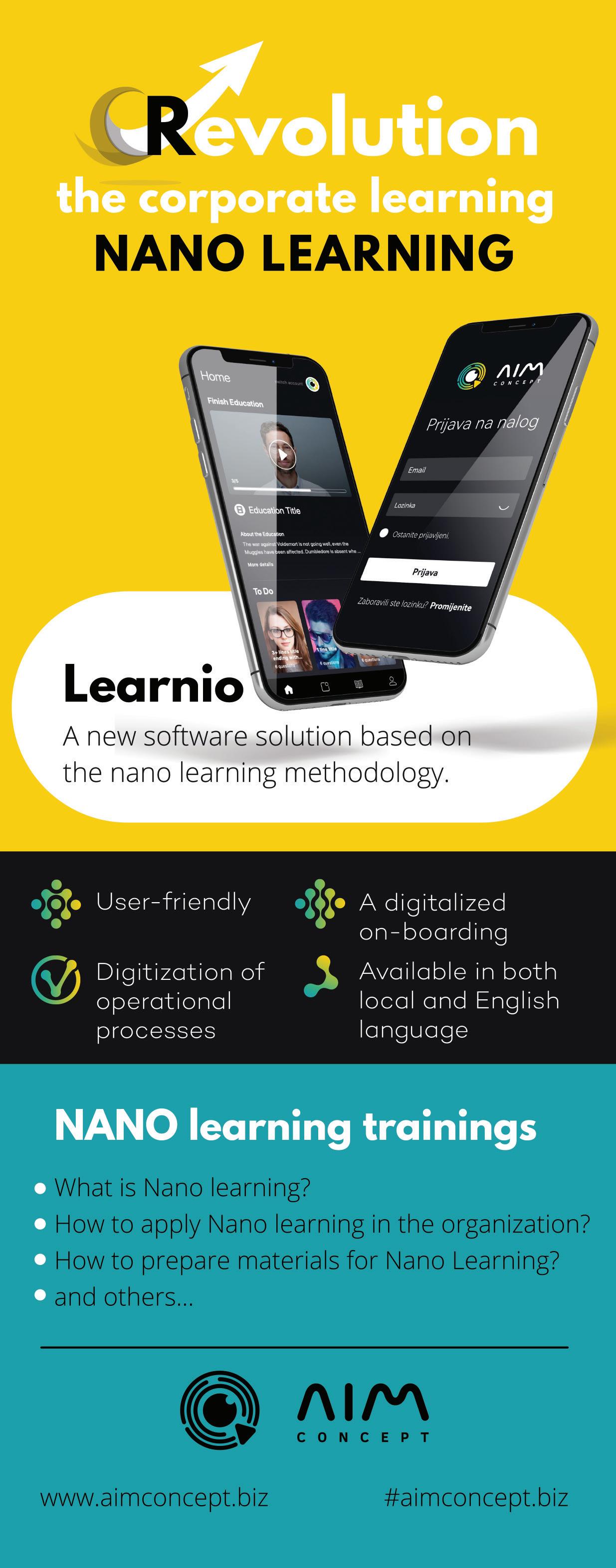
The Candidate as Customer: How Design Thinking Can Improve Hiring Outcomes
Steve Usher, Co-founder, Wonder
56 | HR World 09 April 2023 EXPERIENCE
Candidate experience. A topic that continually comes in and out of focus. Heavily linked to periods of hiring and redundancy cycles, with the latter increasing applications and stress testing organizations' ability to deliver simple, timely, or even human experiences. And yet we find ourselves continually finding examples highlighting there is still work to be done.
April 2023 | HR World 09 57 EXPERIENCE
Here's a beautifully thought-out question asked during an application process;
"How do you feel life has worked out for you so far? Please record a short, roughly 2-5 minute video response, and paste the link here.
We recommend using loom.com (it's free), or you can use any tool you prefer."
Here's another genuine example of a hiring policy at a gaming company, bearing in mind the competitive nature of talent in this industry:
"If they've applied for a role and been rejected at any point, we will not consider them again, ever". You heard it right. Whether you were rejected at the CV or final stage and you try to apply again years later you won't be considered. Rejected means rejected. Forever.
This craziness needs to stop. We need human-first mindsets, common sense, and getting back to the basics of recruitment.
Customer - Employee - Candidate. It's all the same.
Call it what you want, but in principle, the basic needs and hygiene factors are similar;
Communication : Just as customers expect clear and timely communication, candidates also appreciate prompt and transparent communication throughout the hiring journey.
Personalization : Customers appreciate personalized experiences catering to their specific needs, which is valid for candidates. Creating a tailored candidate experience can help them feel valued and more invested.
A voice: Customers are regularly asked to provide feedback on their experience, whether positive or negative. Similarly, candidate experience listening tools enable us to capture feedback at critical touchpoints in the hiring journey.
Ease of use: Employees want an easy and seamless experience when booking vacations or information on their benefits. Candidates also want an easy and transparent application and interview process.
Timeliness: As customers, we appreciate timely service, and candidates appreciate a convenient hiring process. Keeping candidates informed and providing a clear timeline for what's expected and when - is essential.
Clarity: Customers want clear and accurate information and candidates wish the same. Clarity about the job requirements, expectations, and company culture can help them make informed decisions.
EXPERIENCE
If the topic of candidate experience was an app on the app store, how many stars would you give as a rating? What comments would we read in the review section? I'll go with 1.5 stars and "never heard back" as the most common feedback
The expectation effect
If the topic of candidate experience was an app on the app store, how many stars would you give as a rating? What comments would we read in the review section? I'll go with 1.5 stars and "never heard back" as the most common feedback.
So when it comes to job seeking, we have an expectation issue. I have yet to hear of many people turning the sprinklers on and dancing around on the lawn, celebrating that they're entering the job market, whether by choice or circumstance. We go in almost dreading it, safe in the knowledge that we will spend significant time filling out applications, press submit, and never hear back or receive any communication. Ever. And that's ok.
This is where the expectation effect comes to mind. A phenomenon where a person's expectations about a particular outcome can influence their actual experience. In other words, if someone expects a specific result, it can affect their perception of reality.
Regarding candidate experience, the expectation effect can significantly impact how job seekers perceive the hiring process and their potential employer. Suppose a candidate has high expectations of the company and job. In that case, they may be more likely to have a positive experience throughout the hiring process. On the other hand, if a candidate has low expectations, it may be more difficult for them to have a positive experience.
Effective communication is critical to developing your minimum expectation benchmark by setting and establishing realistic expectations from the start. Creating opportunities to showcase your employer brand, create a memorable experience, and attract top talent by intentionally exceeding them whenever possible.
Design a new experience
What learnings can we draw when using design thinking to craft a new experience?
Design is a powerful mindset, with one of the significant benefits being that you're engaging the business and key stakeholders and taking them on a journey of discovery.
Creating space for people to be heard, capturing their voices, and co-creating solutions. This is the core basis of employee experience design, doing things for and with people, not to them. Builds trust, innovation, and adoption of solutions in the long run.
Some key learnings:
• Empathize with everyone who touches the hiring journey - Candidates, Hiring Managers, Recruiters, Interviewers, or HR. When discussing the candidate experience, remember this is just one perspective and an outcome based on other factors. This crucial first step encourages you to put aside your assumptions that you think are right and take the time to truly understand stakeholder needs, pain points, and aspirations. When seeking a multi-lens perspective, opportunities to create a more connected, engaging, personalized experience naturally increase.
• Fall in love with the problem, not the solution: Reduce the risk of betting it all on one solution. The need for speed can often create situations where we unearth new issues and want to jump straight to solution mode. This is consistently one of the most common mistakes we observe. Resist the urge and stay in the problem space longer, and you'll generate a steady stream of innovations.
• Get into the journeys: I invite you to reflect on all the experiences along your hiring process. Which ones are serving you well? Where can you create a better experience intentionally built on a solid understanding of people's needs? Considering the 'sea of ordinary' hiring processes, there's a huge opportunity to create memorable moments to stand out and increase candidate engagement.
• Intentionality and human-focused: The opposite end of intentionality is the default. Whether you're aware of it or not, experiences are currently happening. The question is - How intentional are you about the ones that impact hiring the most?
A journey back to the 1980s
I love the 80's. Back to the future, Michael Jackson, E.T., Levi's, legwarmers, shoulder pads, electric color weaves, and Prince.
It was a decade that kept on giving, even in recruitment.
Picture someone from the movie Wall Street. Crisp white shirt, red braces, and a Motorola brick phone. This is Tony Byrne - a recruiter, trainer, and the creator of the 30-step recruitment program He talked about the placement process being simple. However, it's the problems that we solve within the process that is complicated. Mainly because, as recruiters, we're constantly dealing with the most complex being on the planet. Humans. The 30-step program is a methodical, detailed, and highly efficient process. When I introduced this into my recruitment agency business in the 2000s, we saw a dramatic increase in our revenue, CV-to-placement ratios, and overall quality of our work. Forging a solid reputation and brand as a trustworthy consultancy business in our industry.
April 2023 | HR World 09 59 EXPERIENCE
By breaking the recruitment process down into these steps, we modularised the competence, skills, and mindset needed for each stage. From taking an effective job order from a hiring manager, creating control, a recruiting plan, interviewing, preparations, and debriefing for candidates and hiring managers - before and after interviews, pre-closing, presenting offers, negotiations, through to resignation preparation, and dealing with counter offers. When executing this methodology, you're operating at the strategic end of the market. As opposed to the other end - reactive and transactional recruitment. Typically attributed to a high street agency approach.
This is where some companies have lurched toward the transactional side, resulting in a reactive talent acquisition function, lower levels of the recruiter / hiring manager relationships, and perhaps perceived more as a service provider rather than a strategic partner.
Closing thoughts

This is a reminder that there's a sea of normal recruitment processes in the world. People tend to experience very similar hiring processes. Consider recreating a more memorable experience using design thinking. Set aside your assumptions and preconceived solutions and spend time understanding people and their needs. Now is the time to invest in your TA function and team. Equip them with the skills, mindset, and mandate to own the process, build relationships with hiring managers, and develop as strategic partners, not reactive or transactional. A highly competent recruiter is worth their weight in gold in a competitive talent market.
Focus on creating an experience for everyone, not just candidates. This requires just as much intentionality as the hiring manager and recruiter experience. When your TA function, team, and hiring managers are well-aligned it will significantly enhance the candidate experience as a natural byproduct.
A highly competent recruiter is worth their weight in gold in a competitive talent market
5 YEARS OF HR WORLD

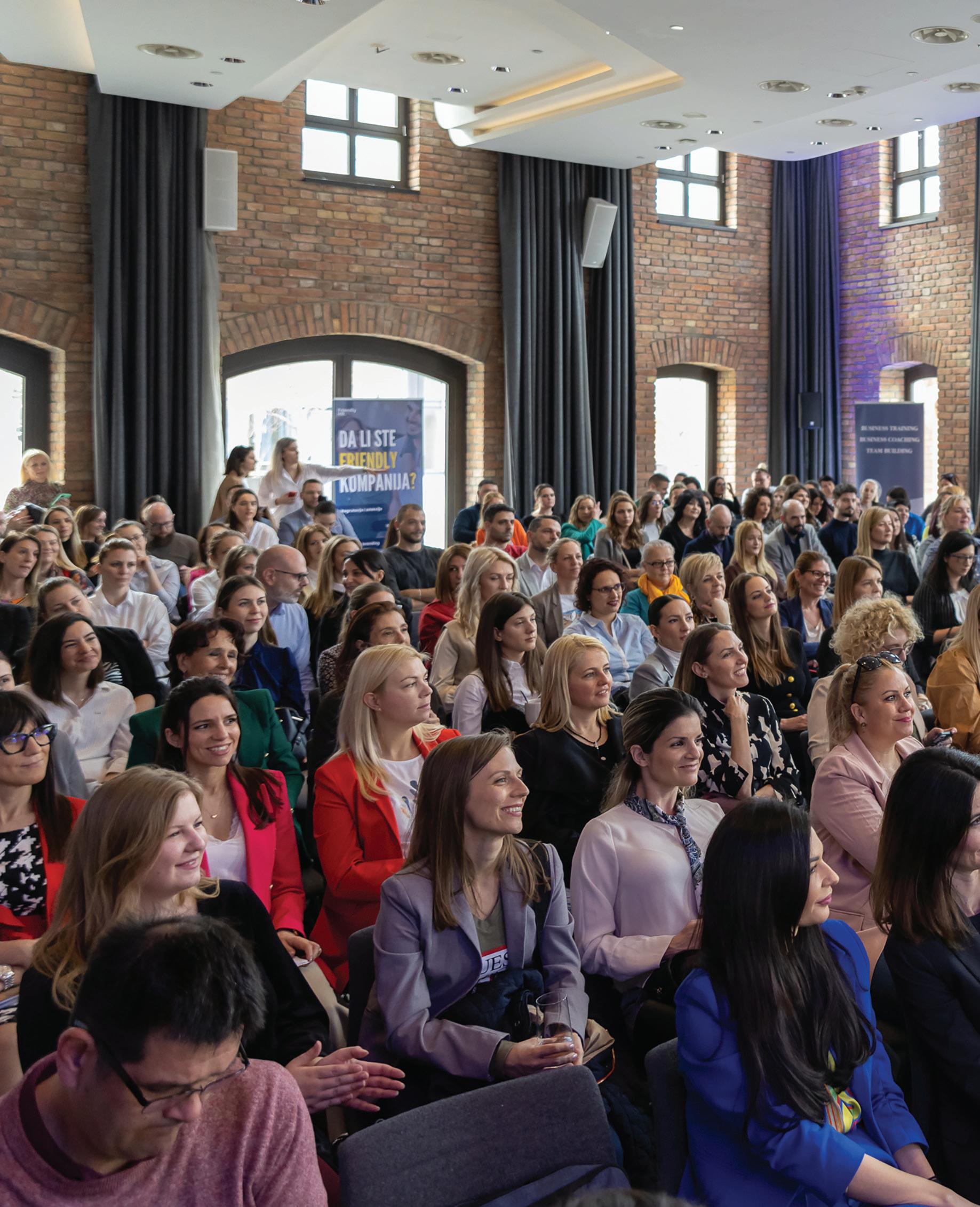
5 YEARS OF HR WORLD
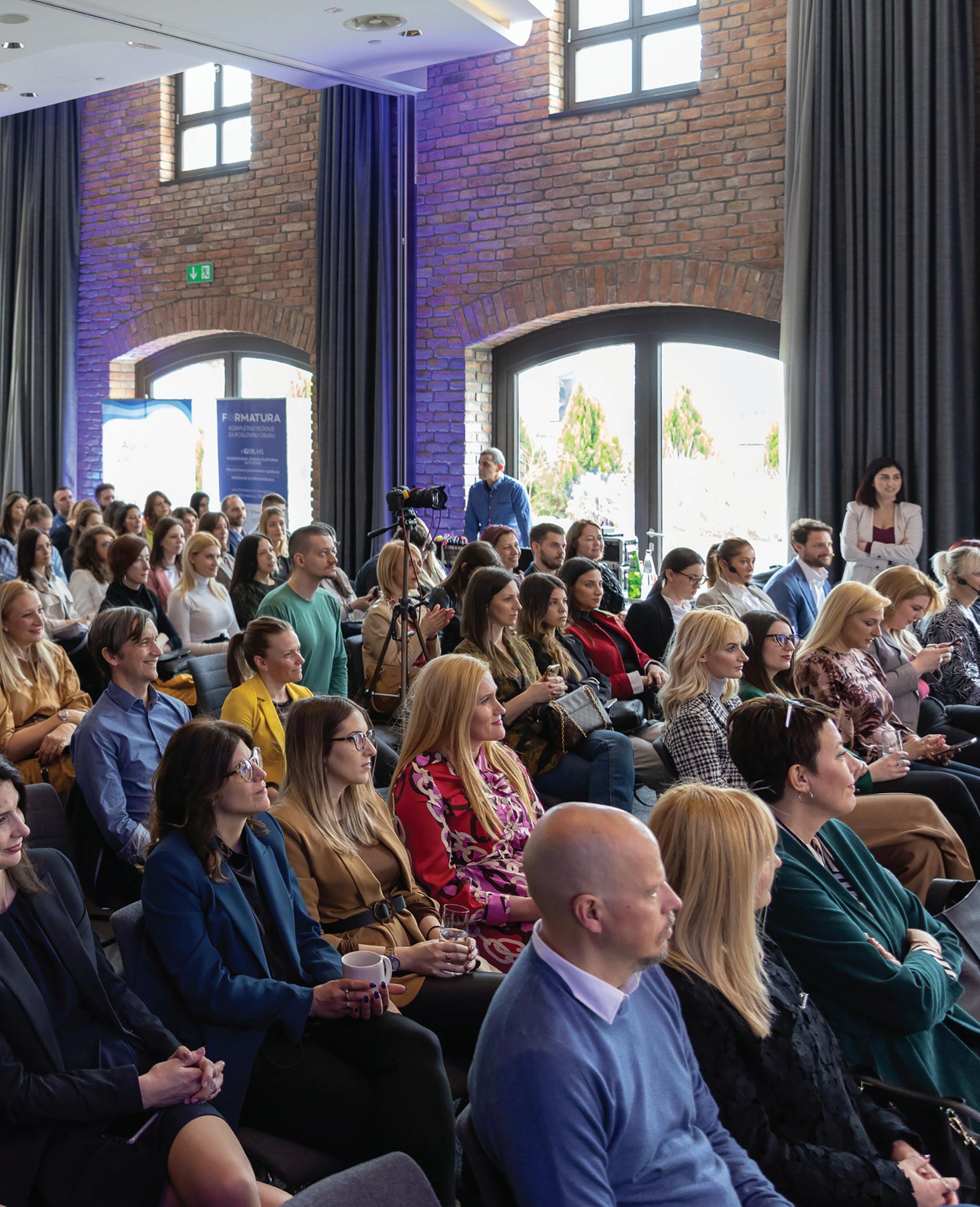

5 YEARS OF HR WORLD


5 YEARS OF HR WORLD

April 2023 | HR World 09 67

5 YEARS OF HR WORLD

THE WORKSTYLE IMPACT ON MENTAL HEALTH AND WELL-BEING, PRODUCTIVITY,
SOCIETY
THE WORKSTYLE IMPACT ON MENTAL HEALTH AND WELL-BEING, PRODUCTIVITY, AND SOCIETY
Workstyle gives people the freedom to choose when and where they work rather than mandating flexible, hybrid, remote, part-time, or office-based approaches. Workstyle is therefore an individualized system of work - designed by the individual so that their work fits around their life and not the other way around. This means working without an office or office hours, but instead using online tools to collaborate with one another at times that suit us as individuals.
70 | HR World 09 | April 2023 TRENDS
AND
Alex Hirst, Co-Founder, Workstyle Revolution, Lizzie Penny, Co-Founder, Workstyle Revolution
Workstyle gives people the freedom to choose when and where they work rather than mandating flexible, hybrid, remote, part-time, or office-based approaches. Workstyle is therefore an individualized system of work - designed by the individual so that their work fits around their life and not the other way around. This means working without an office or office hours, but instead using online tools to collaborate with one another at times that suit us as individuals. We have written a book about this simple word because we believe it can have a profound impact on our future. Workstyle: A revolution for well-being, productivity, and society explains that the one-size-fits-all approach to work is broken and that for businesses to thrive and be fully inclusive, they need to embrace a new way of working, which we call ‘workstyle’.
The benefits of this autonomous way of working include improving well-being, increasing productivity, and bettering society as a whole by opening up the world of work to many groups of traditionally excluded people. For example, 82% of people without disabilities work, but only 53% living with disabilities do1. 45% of those with mental health problems are in employment, compared to 74% of the
1 Andrew Powell, House of Commons Briefing Paper Number
7540 Disabled People In Employment
(2021) https://researchbriefings. files.parliament.uk/documents/CBP7540/CBP-7540.pdf
population2, and only 26% of people with autism work3 when 77% want to4
In 2015, we started Hoxby to prove that this autonomous method of work can be the digital-age replacement of the industrial 9-5 system. Since then, we have completed projects for more than a hundred clients, answering briefs across marketing, creative, communications, HR, and innovation for small businesses and large corporations in all sectors across the globe. Not only has the business proved that the workstyle method works, we have also undertaken our own research to validate why it works.
Our longitudinal study began in 2019 to explore the relationship between autonomy, well-being, and productivity within the Hoxby environment. Over three years of conducting the study, Hoxby scored highly for autonomy, well-being, and productivity. We also looked at the relationship between the variables and found that
2 NHS England, The five year forward view for mental health (2016) https://www.england.nhs.uk/wpcontent/uploads/2016/02/MentalHealth-Taskforce-FYFV-final.pdf
3 Office for National Statistics, The employment of disabled people 2021 (2021) https://www. gov.uk/government/statistics/ the-employment-of-disabledpeople-2021
4 National Autistic Society, The Autism Employment Gap (2016) https://www.base-uk.org/sites/ default/files/knowledgebase/nas_ tmi_employment_report_24pp_ web.pdf
they were all strongly, and positively correlated. High levels of autonomy were associated with high levels of both well-being and productivity. The data implies that the Hoxbies who feel most autonomous (and have lots of control over setting and respecting their workstyle), are also the happiest and most productive. Interestingly, well-being and productivity also remained high in a year when the global pandemic challenged people’s mental health like never before. Workstyle helped protect Hoxbies from the negative effects, with both productivity and well-being actually increasing, against the odds.
Lastly, the research found that well-being explained the relationship between autonomy and productivity. It is through well-being that autonomy affects productivity. The implication is that productivity can be increased by improving well-being.
Creating an autonomous working environment through the setting and respecting of workstyle is one of the best ways to do this - it boosts well-being, and that in turn is responsible for boosting productivity. Workstyle is making revolutionary progress in improving well-being, and therefore productivity, through a system of work that puts autonomy and individualized working at its heart. So, how does it actually work? We believe that for autono-
mous working to succeed, an organization must evolve its fundamental ways of working in three ways:
Evolution 1: Be digitalfirst, not physical first. This means resetting the assumption that work is normally done in a shared place, with the assumption that work is normally done online. At Hoxby, this means collaborating with people via Slack rather than across a boardroom table, brainstorming via Miro rather than via whiteboard, and using post-its under fluorescent lighting.
Evolution 2: Work asynchronously not synchronously. This means using technology to create ways of working that are
April 2023 | HR World 09 71 TRENDS
It is through well-being that autonomy affects productivity. The implication is that productivity can be increased by improving well-being.
Creating an autonomous working environment through the setting and respecting of workstyle is one of the best ways to do this.
TRENDS
primarily done to individual schedules rather than shared schedules. Hoxbies communicate via messages, emojis, gifs, and video clips rather than face-to-face meetings of turn-taking conversations.
Evolution 3: Value trust, not presence. This means trusting people to deliver their value through their outputs rather than assuming their presence equates to their value. This fosters a sense of accountability that is necessary for autonomy to succeed and is something that is role modeled by leaders at Hoxby, as well as being continuously recognized and rewarded.
With these fundamental changes to the way an organization works comes a newfound requirement for accountability among its people. Autonomy can not exist without accountability. This is something that workers need to understand - a new level of accountability to deliver your work comes with the gift of autonomy.
Once understood, the benefits of autonomy can be enjoyed. Studies have found that those with more autonomy take greater pride in, and are more emotionally attached to their work5
Work-life balance6 7, job satisfaction8 9, engagement10, and productivity11 are all improved, while stress12, staff turnover13, and exhaustion14 are decreased. Efficiency has also been found to increase as people are able to choose their optimal
6 K. Byron, ‘A meta-analytic review of work–family conflict and its antecedents’, Journal of Vocational Behavior, 67:2 (2005), 169-198.
7 C. Gerdenitsch, B. Kubicek and C. Korunka, ‘Control in flexible working arrangements: When freedom becomes duty’, Journal of Personnel Psychology, 14:2 (2015), 61-69.
8 L.M. De Menezes and C. Kelliher, ‘Flexible working and performance: A systematic review of the evidence for a business case’, International Journal of Management Review, 13 (2011), 452–474.
9 R. Gajendran and D. Harrison, ‘The good, the bad, and the unknown about telecommuting: Meta-analysis of psychological mediators and individual consequences’, Journal of Applied Psychology, 92:6 (2007), 1524-1541.
10 L. Ten Brummelhuis, A. Bakker, J. Hetland and L. Keulemans, ‘Do new ways of working foster work engagement?’, Psicothema, 24 (2012), 113–120.
11 C. Gerdenitsch, B. Kubicek and C. Korunka, ‘Control in flexible working arrangements: When freedom becomes duty’, Journal of Personnel Psychology, 14:2 (2015), 61-69.
12 R. Gajendran and D. Harrison, ‘The good, the bad, and the unknown about telecommuting: Meta-analysis of psychological mediators and individual consequences’, Journal of Applied Psychology, 92:6 (2007), 1524-1541.
working conditions15, save time and energy by reducing commuting time16 17, and are forced to communicate more effectively18. So the academic literature overwhelmingly supports our primary research in finding that autonomy positively impacts well-being and productivity.
In summary, our dedication to the industrial-age 9-5 system of work and all of its rigidity is creating an increasing amount of friction with the digitallyenabled fluidity with which we are able to conduct the rest of our lives. Applying that same level of autonomy to our working selves can liberate us from this mechanical grip for the benefit of our well-being, our productivity, and society now and long into our future.
15 E. Van Steenbergen et al., ‘Transitioning towards new ways of working: Do job demands, job resources, burnout, and engagement change?’ Psychological Reports, 121:4 (2017), 736–766.
5 G. Petriglieri, S. Ashford and A. Wrzesniewski, ‘Agony and ecstasy in the gig economy: cultivating holding environments for precarious and personalized work identities’, Administrative Science Quarterly, 64:1 (2018), 124-170.
13 R. Gajendran and D. Harrison, ‘The good, the bad, and the unknown about telecommuting: Meta-analysis of psychological mediators and individual consequences’, Journal of Applied Psychology, 92:6 (2007), 1524-1541.
14
16 Clare Kelliher and Dierdre Anderson, ‘For better or for worse? An analysis of how flexible working practices influence employees perceptions of job quality’, The International Journal of Human Resource Management, 19:3 (2008), 419-431.
17 E. Van Steenbergen et al., ‘Transitioning towards new ways of working: Do job demands, job resources, burnout, and engagement change?’ Psychological Reports, 121:4 (2017), 736–766.
18 L. Ten Brummelhuis, A. Bakker, J. Hetland and L. Keulemans, ‘Do new ways of working foster work engagement?’, Psicothema, 24 (2012), 113–120.
72 | HR World 09 April 2023
L. Ten Brummelhuis, A. Bakker, J. Hetland and L. Keulemans, ‘Do new ways of working foster work engagement?’, Psicothema, 24 (2012), 113–120.
82% of people without disabilities work, but only 53% living with disabilities do. 45% of those with mental health problems are in employment, compared to 74% of the population, and only 26% of people with autism work when 77% want to.
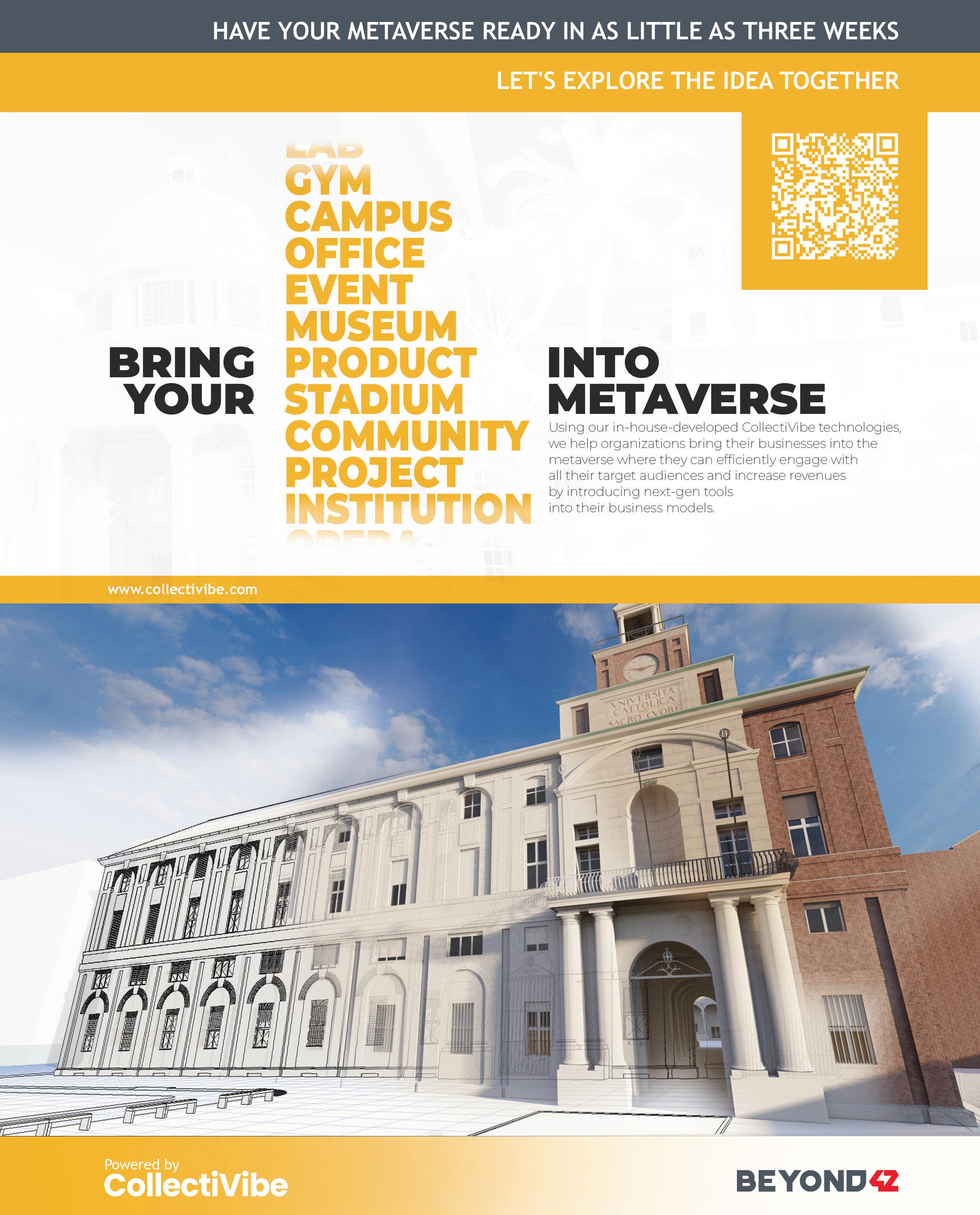
STUDY ABROAD
Bachelor’s, Master’s, MBA’s programs, short programs and conferences

Building a Culture of Care: How L&D Can Drive Well-being in the Workplace
Dr. Milana Malešev, PhD A CIPD Qualifications Tutor, Founder of Learning Makeover, and an Associate Professor of Social and Organizational Psychology, FEFA
April 2023 | HR World 09 75 DEVELOPMENT
Based on the Health and well-being at Work report (CIPD, 2022) the most common causes of stress at work (in %) are:
e.g. Base: 482.
Company-related stressors from this list depend on many factors outside of typical HR responsibilities - the business model, how the organization is structured, how the processes are designed, etc. However, there is room for L&D's contribution to reducing them.
An HR colleague told me: I know it would be ideal to start from the top and set all the basics right, but it will take years. I want to support our employees now, to help them manage their stress in this imperfect environment
It is vital to be honest, and position our message regarding well-being initiatives similarly. Because, people often get cynical about them: You don’t reduce
my workload, I can’t get a pay increase, but you're giving me stress management training instead?!
I learned a lesson about positioning well-being programs early in my career. As a psychologist, I delivered stress management training to different clients, and I loved it. But then I encountered a tough group of participants who resisted everything I did. Although my approach was tested in the previous groups, it didn't work with them - a painful experience but a great lesson too.
When I gave up my slides and switched to a non-directive approach, I found out that these people worked in a toxic environment, and they interpreted
76 HR World 09 | April 2023 DEVELOPMENT
The leadership style is something L&D can influence through management development programs
Workloads/volume of work
Non-work factorsrelationships/family
Management style Non-work factors - personal illness/health issue
COVID - related anxiety (eg fear of contagion in the workplace/commute)
Non work-related demands of challenges due to homeworking as a result of COVID-19
Poor work-life balance due to homeworking as a result of COVID-19
60 27
24
Pressure to meet targets and/or deadlines
26 25 23 22 20
our training as another manipulation tool. They understood the message from the company as: We are training you to manage stress. So, from now on, when you're stressed out, that's your fault!
As a result of this experience, I learned to be much more careful in assessing my clients’ needs (and their implicit agendas).
To summarize, first, we must ensure that our intentions behind wellbeing initiatives are serving the needs of the people. Second, we need to communicate our intentions honestly. In any other case, people will be (rightfully) resistant.
Now, let's look at the programs L&D can provide to support employees’ well-being.
We will first focus on the programs to reduce many of the stressors listed above. Then, we will cover the programs to strengthen people's capabilities to avoid and/or cope with stress.
The article A Meta-Analysis of the Relative Contribution of Leadership Styles to Followers’ Mental Health (Montano, Schleu & Hüffmeier, 2023), including 53 studies with 93,470 participants, shows a clear association between leadership style and employees' mental health. The strongest predictors of positive mental health among employees were relations-oriented and task-oriented leadership.
The leadership style is something L&D can influence through management development programs.
Which topics are most relevant from the well-being perspective?
Helping new managers get up to speed with their new responsibilities is very
helpful. A manager who understands the work that needs to be done, with all its elements (including the procedures to be followed and interaction with people outside the team), can plan and delegate tasks effectively. If they are unfamiliar with what their projects include, they will often become surprised and delegate assignments with pressing deadlines. More than planning and organizing skills, this is about understanding what it takes to do the job. Having a mentor will be a more effective way of developing this than formal training.
Developing project management, planning and organizing, and time management skills will also greatly help. Well-organized managers rarely give last-minute tasks and create a hectic environment in their teams. Learning to delegate effectively means that work will be divided equally, people will be clear about what they are expected to do, have regular contact with their manager, and get timely feedback and guidance. Situations when they are left to ponder whether they're on the right track, can’t reach the manager to get crucial information, or the last-minute reworks of what they've done should be reduced significantly. Can you imagine how much stress could be avoided?
Communicating effectively can significantly reduce stressors such as criticism or lack of feedback. Skillful communicators can also set boundaries and protect their teams from unrealistic clients’ or organizational demands. Additionally, managers are the first line of defense from escalating conflicts within their teams.
Great management development programs allow participants to explore common challenging issues. For example, finding the right balance
April 2023 | HR World 09 | 77 DEVELOPMENT
There are many ways in which educating managers and employees can support their mental health and overall culture of care in the company.
Therefore, L&D should confidently sit at the table when the well-being strategy is being created
between trust and control, between being a “boss” and a “friend,” or handling numerous stakeholders with conflicting needs. Normalizing these challenges and helping managers find the most effective approach will make their lives easier and prepare them for their pivotal role in the well-being strategy.
All the topics mentioned so far aim to prevent everyday stressors in the workplace. But managers also have an essential role in spotting mental health issues in their teams and reacting quickly.
This is not a common skill, so L&D needs to educate managers on how to check in regularly with people, the early warning signs of poor mental health, and the expert sources of help to refer to their people.
Supporting managers in this role indirectly yet significantly influences organizational culture in destigmatizing mental health issues and normalizing asking for help.
To summarize, investing time and effort to build great managers in your organization will contribute to achieving business results and drive well-being by creating a culture of care.
The second approach L&D can take in supporting well-being in the company is building and strengthening skills for coping with stress among the employees.
We all work in imperfect workplaces, and we experience stress. A new manager, challenging project, heavy workload, difficult colleagues, or clients… We encounter these situations more or less frequently. Therefore, everybody can benefit from understanding what stress is, why it exists, and which constructive strategies we can take to cope with it.
But we cannot expect everybody to be aware of this need and excited about the opportunity to learn. So, it is our job as L&D professionals to raise awareness among employees about which of
their pains could be avoided if they implemented effective stress management strategies.
For example, if we are more realistic regarding how we expect our clients to behave, we might be less affected by their negative behaviors.
We can raise awareness by crafting messages to acknowledge their pain and how our program can help them reduce or avoid it. We can also provide a self-assessment of stress management strategies so they identify the areas for improvement and get motivated for change.
In my experience, the best programs to build stress management strategies are very practical and context-specific. This means participants have many opportunities to discuss and try new methods relevant to their jobs. A group of participants from the same environment with similar problems is very resourceful. Many have already found valuable ways to approach problems, and everybody benefits significantly from sharing them. Even knowing you are not alone in your concerns can bring relief.
Another approach that worked very well in my workshops was bringing credible senior people from the company to share their journey of developing personal resilience. It is essential to pick the right person for this task – somebody who is committed to their personal development, introspective, and interested in helping people grow. By sharing their stories, these senior people provide enormous value.
First, they normalize issues employees have. By sharing stories of issues and
78 HR World 09 | April 2023 DEVELOPMENT
L&D needs to educate managers on how to check in regularly with people, the early warning signs of poor mental health, and the expert sources of help to refer to their people
negative emotions they experienced, they implicitly permit employees to feel that way too.
Second, they can provide specific tips on approaching certain situations. For example, how do you follow up on your email to a senior manager (who still needs to respond) because you urgently need info to continue your work? In a company I worked for as a consultant, this was a common cause of pressure and frustration. The senior manager, a guest lecturer, provided clear guidelines on his “gradual escalation” strategy in this situation. Participants’ reception and engagement were terrific, as they learned specific techniques that work and are “approved” in their organizational culture.
To support people in becoming more resilient, L&D can also offer resources and training sessions on healthy eating habits and lifestyle and reducing the risk of chronic health conditions. In these instances, the interventions don’t have to stop at the level of acquiring information. Creating communities centered around topics of interest (e.g., healthy nutrition) can support applying these principles in everyday life. It's far easier to change how you prepare your meals when you have colleagues with whom you can share recipes and cooking tips than when you're left to do it alone.
The last idea for building employees' skills is on the topic of personal finance management. Money limits what we can do and is frequently one of the most
potent stressors in employees' lives. A course covering personal budgeting, debt management, insurance, and retirement planning can help people save more and avoid unnecessary debts.
To conclude, there are many ways in which educating managers and employees can support their mental health and overall culture of care in the company. Therefore, L&D should confidently sit at the table when the well-being strategy is being created.
April 2023 HR World 09 | 79 STRATEGY
The leadership style is something L&D can influence through management development programs
80 HR World 09 | April 2023 WELL-BEING
Milica Helmih, Psychologist/Master's student, Utrecht University SHOP
Whether we are graduates looking for an internship or experienced professionals eager to change our workplace, we cannot deny the urge to find “The one” that will have our names all over the vacancy posted on the job searching website. But what does this actually mean? How do we know if we are “the perfect fit” for the new environment, and how exactly does that affect our well-being and day-to-day work life?
April 2023 HR World 09 | 81 WELL-BEING
How valuable is a person’s fit to the organizational environment and does it enhance well-being and vitality?
AWESOME RETREATS
Person-environment fit is defined as an interaction between the individual and their environment, where the positive fit can bring an individual (in our case employee), while an unsuitable one could be seen as an obstacle to their further development as a professional in a certain context (Holmbeck,


Social psychology teaches us how the surroundings of an individual influence his/her behavior and vice versa. The feeling of not belonging to a certain environment could deteriorate the mental health and well-being of the future
As we probably believe, an employee needs to showcase different qualities and performance in an organizational
could make everything much easier, but not everyone can forecast this or have a background in social or organizational psychology, which would help them to evaluate organizational
Certain findings showed how this variable moderated the relationship between workload and well-being, where the lower the workload is assessed the better the well-being should be, and that correlation should be stronger for those experiencing a high person-environment fit (Furnham & Schaeffer, 1984). Important to mention is that the Person-environment fit theory has a core premise that states that stress arises not only from the person or environment itself but from their congruence with one another (Edwards, Caplan & Harrison, 1998). This term has been used as an “umbrella term” to better explain a person’s compatibility with different aspects of the
Since this variable has shown to be signific, we can ask ourselves, how could managers use this knowledge to make their organizational climate a better fit for their workers?
Let’s take into consideration organizational climate as a personality of the organization (Jay, n.d.), the traits it has,
-
Write to us at retreat@mindfulmate me
What happens when an employee has a different personality in comparison to the work surrounding they found
YES, WE DO CREATE FOR YOUR TEAM.
how it deals with certain challenges, and preferred workstyle, much similar to what one person could showcase. What happens when an employee has a different personality in comparison to the work surrounding they found themselves in? Previously mentioned research showed undesirable statistics.
Well-being, which is found at the center of attention, is considered to have many aspects. We can try to describe them, but that would exceed the length of this article. From what we know up until now, employees need to be vital and show eagerness and intrinsic motivation to complete tasks, which will lead to accomplishments and successful organization. To briefly present it, we can say that well-being is considered to fall under two traditions, one is hedonistic which promotes happiness, and the presence of a positive effect, and the absence of a negative effect. The eudaimonic aspect is emphasizing living life to the fullest potential and in a deeply satisfying way. It is considered to be the presence of optimal psychological functioning (Deci & Ryan, 2008).
It is shown to be particularly important in organizations regarding individual and organizational-related health issues (Wright & Huang, 2012). One important factor which is also salient when it comes to well-being is the vitality of employees – it is considered to be essential for employees to show thriving in the workplace. Vitality preserves one from negative emotions, such as worry and depression, and increases people’s resilience toward stressful situations. Vitality prevents the experience of negative physical and mental states and it is argued that vitality at work promotes employees’ physical and mental health (Kleine et al., 2022).
Well-being is not only providing your employee with benefits and making sure that their physical wellness is taken care of, but allowing them to talk to someone, to express their needs, ideas, and interests is crucial for their well-being and vitality. Here is where we go back to our main variable - personenvironment fit.
Not only does it promote well-being but it also helps individuals to maintain good relationships with their colleagues and achieve affiliation or social support. Having support at the workplace, strengthened with good relationships with other team members promotes well-being, makes coping with stress easier, and overall is shown to be a good facilitator of wellness. On the other side, those who prefer less social interaction, the so-called introverted employees, the ones that don’t find much enjoyment in forming good relationships at their workplace, are experiencing a lower possibility to find support in their surroundings and therefore experience lower well-being (Yang, Che & Spector, 2008).
What is the organization’s task here?
Using different tools which would provide them with information about the employee’s personality is crucial here. Psychological assessments could be a powerful way of getting to know who is a part of the organization and how they can both benefit from having them on the team. Providing a chance to find out more about personality traits and everything that makes individuals who they are is the organization’s way to provide a flourishing surrounding for the member, knowing how to balance out their work style, needs, which tasks they are most comfortable with, and how to make the less enjoyable ones more bearable.
This is to be achieved with the help of both external and internal professionals who would coach managers and employees about different personality types and how these could be used for successful team development. Understanding different types of people and how they function in teams gives them the sense of
April 2023 HR World 09 | 83 WELL-BEING
Employees should also have their way of knowing whether they fulfill the organization’s needs, and providing them with feedback and explaining to them how to use their qualities and strengths enables them to feel more appreciated and increases their motivation
being important and valuable to the organization. Psychological assessments have taken a huge leap and recently became one of the most commonly used tools for making decisions in the company (Church et al., 2016).
Employees s hould also have their way of knowing whether they fulfill the organization’s needs, and providing them with feedback and
explaining to them how to use their qualities and strengths enables them to feel more appreciated and increases their motivation.
For example, using 360-degree feedback tools is also a good way of providing employees with information about their performance and engagement in the company.
Here we numbered two examples that are going in both directions (employees-organization) and are valuable assets to both sides of this story. When providing these tools, we might not even recognize how greatly we can contribute to enhancing person-environment fit and further developing better well-being. The constant development of such tools is a powerful way of allowing the organization to use the full potential of its workforce. The main idea behind these concepts is to encourage managers and team leads to better understand and meet their team in order to promote their well-being.
REFERENCES:
Edwards, J. R., Caplan, R. D., & Van Harrison, R. (1998). Person-environment fit theory. Theories of organizational stress, 28(1), 67-94.
Yang, L. Q., Che, H., & Spector, P. E. (2008). Job stress and well-being: An examination from the view of a person-environment fit. Journal of Occupational and Organizational Psychology, 81(3), 567587.
Uppal, N. (2021). Mediating effects of person–environment fit on the relationship between high-performance human resource practices and firm performance. International Journal of Manpower 42(3), 356-371.
Deci, E. L., & Ryan, R. M. (2008). Hedonia, eudaimonia, and well-being: An introduction. Journal of happiness studies, 9(1), 1-11.
Kleine, A. K., Rudolph, C. W., Schmitt, A., & Zacher, H. (2022). Thriving at work: an investigation of the independent and joint effects of vitality and learning on employee health. European Journal of Work and Organizational Psychology, 1-12.
Furnham, A., & Schaeffer, R. (1984). Person‐environment fit, job satisfaction and mental health. Journal of occupational psychology, 57(4), 295-307.
Wright, T. A., & Huang, C. C. (2012). The many benefits of employee well-being in organizational research. Journal of Organizational Behavior, 33(8), 1188-1192.
Holmbeck, G. N., Zukerman, J. I. L. L., & Zurenda, L. A. U. R. E. N. (2007). Theoretical foundations of developmental-behavioral pediatrics. Developmental-Behavioral Pediatrics: Evidence and Practice E-Book 13, 13-45.
Shani J. (n.d.). What is Organizational Climate? 7 Steps to Improve Yours. AIHR Blog. https://www. aihr.com/blog/
WELL-BEING
Psychological assessments could be a powerful way of getting to know who is a part of the organization and how they can both benefit from having them on the team
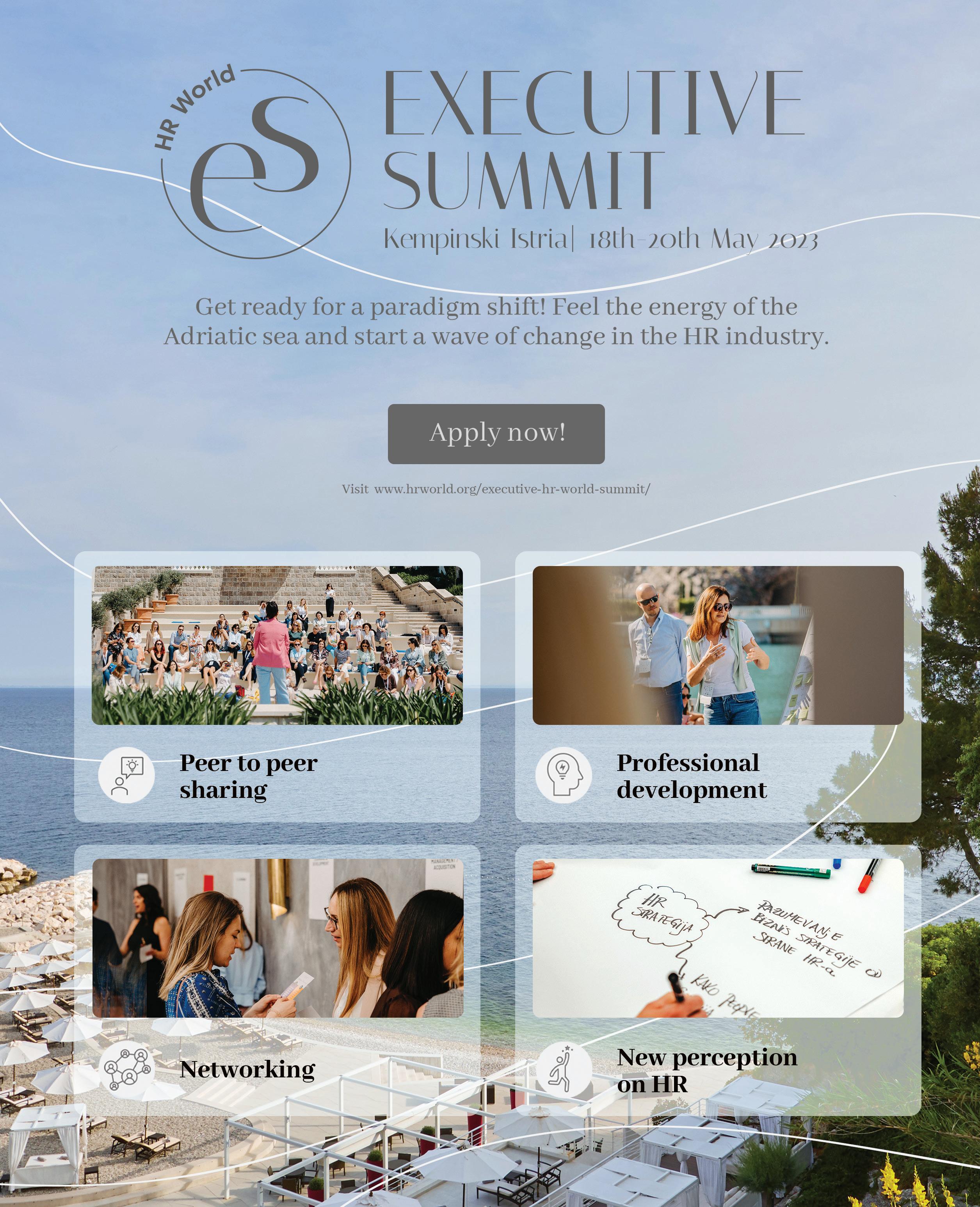
Putting people first: How to address employee well-being?
Jasmina Ridzi, HRM Consultant, FledgeWorks
Employee well-being is not just a hype trend. When employees' well-being is thriving, the company directly benefits - employees take fewer sick days, deliver higher performance, and burnout and turnover rates are lowered. Employee well-being is of paramount importance for work productivity, and is also an important criterion that candidates use when choosing a job and deciding whether to stay at a job or find a new one.
What is employee well-being?
It isn't just physical fitness or eating well. It's about how people's lives are thriving. Well-being encompasses all the things that are important to each of us and how we experience our lives.
There are 7 key areas of well-being:
• Career well-being – Work and growth according to potential and interests.
• Social well-being – Supportive relationships with family, friends, and co-workers.
• Financial well-being – Managing the finances well.
• Environmental well-being – How the environment positively affects well-being.
• Physical well-being – Healthy habits and routines for energy to act.
• Mental well-being – Coping well with daily life situations and challenges.
• Spiritual well-being – Finding meaning and purpose in life.
Where to start in building employee well-being?
We must reconsider our attitude towards employe es. Are they regarded as a resource or capital, as the name HRM or HCM suggests, or as persons with their own needs, goals, and desires? For a humancentered approach, we must introduce HXM - Human Experience Management. We must tailor all processes in the employee lifecycle accordingly to ensure their good experience
86 | HR World 09 April 2023 WELL-BEING
How to ensure employee well-being?
In the above-presented processes, we must cover the 7 areas of well-being. The most important is career wellbeing. As employers, we must address it firs t.
Career well-being

• Put the right people in the right positions. By using a potential and strengths-based strategy, we will be able to create a culture of high performance and satisfaction.
• Human-centered leadership puts people first. Being human-centered shapes our communication style, our mindset, and our sense of trust.
• Provide growth opportunities with learning, upskilling, and career development processes. Discuss the possible career paths with employees.
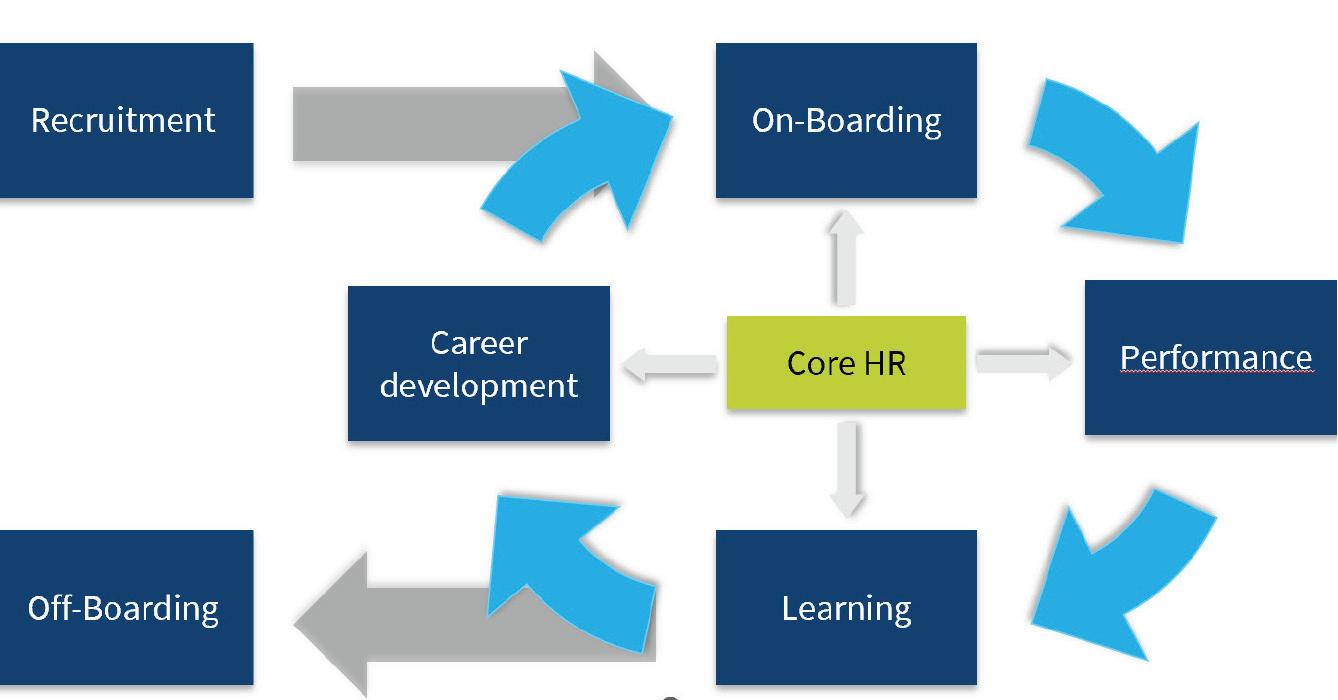
• Recognize and reward employees. Reaffirming that they’re doing a good job gives employees a sense of fulfillment, builds their confidence, and therefore helps them feel more engaged at work.
We can address other areas of well-being in the following ways:
• Build an open and collaborative company culture.
• Implement technology for effective and satisfying work.
• Establish physical wellness programs and bonuses.
• Encourage work-life balance.
• Introduce an employee assistance program (EAP).
• Encourage mindfulness and meditation activities.
Benefits of employee well-being
The aforementioned programs are proven to reduce staff turnover, improve productivity and efficiency, boost performance, and reduce absenteeism. Companies that focus on this will be better positioned to attract and retain top talent. When people are in a state of well-being at work, they are able to develop their potential, be productive and creative, build positive relationships with others, cope with stress in a better way, and make meaningful contributions. They also help create better places to work and, in general, help companies make the world a better place.
Picture1: Processes in the employee lifecycle
HR IN STARTUPS WHO NEEDS IT?















 Nebojša Bjelotomić, CEO, Digital Serbia Initiative
Nebojša Bjelotomić, CEO, Digital Serbia Initiative
For CEOs, HRs are those who talk about emotions, empathy, and so on. For startup founders, HRs are perceived completely differently. They provide the structure. It is not easy to put the two worlds together.
88 | HR World 09 April 2023 INTERVIEW
By th eir nature, startups have a lot of things that are not so structured and a problem to structure themselves. For a lot of startups, HR is about codes and guidelines, and, being completely opposite, HRs can try to give them the structure they need.
When does a startup need HR?
1) When it reaches 20-30 employees investments
2) According to Y combinators






















3) When it gets to series A investments
(source: ycombinator.com)

In startups, HR should take care of four areas of responsibility:
I Legal protection
A lot of startups believe that the rules of this world do not apply to them, especially the law rules brought by the “boring people from government” and labor laws and taxation... They are driven by desire and energy. In that sense, HRs are the people who bring level-headedness to the startup, taking care of legal protection, because, other than HR, probably nobody will even have a clue that this is much needed.
II Talent acquisition
Startups are the companies that are having this rapid growth, they are innovative, and they're based on technology. This scaling up usually means scaling up in
talent as well. This is where HR really helps, especially if you see the growth from 1015 people to 40-50 people. That initial growth might be the most stressful one.
III Employee training
Startups usually have very strong, either engineering muscle or domain knowledge about the area that they are dealing with. But everything else is lacking. Career Development is especially important because entering a new exciting startup is fun for weeks and months, but not for years. And everybody wants to know “Where is this going further? We're gonna get to the IPO but before we get to the IPO, what's gonna happen to me?” The answer to this is sometimes expected to be given by HR only.
IV Record keeping Record keeping is quite important for the reasons of legal protection.
Startup scanner Serbia, 2022
151 startups in Serbia were a part of a project named Startup Scanner in 2022, which scans startup needs, challenges, plans, etc. Here are the results we got: HR in startups
10% of the startups stated that they already do have HR (most Serbian startups are about 10+ employees). That
means that they got an HR very early on.
What is interesting was their response to the question “What is the most difficult position to fill?” - Human Resources came very low on the list (only 2,6% of startups stated this, and the most voted was tech - 58,9%). This might tell us that they have no idea what they're looking for.
When asked “What are the teams that need expansion in the next 12 months?”, the results were similar - 13,2% of votes for HR teams, as opposed to tech teams with 73,5% votes. To put this into perspective, all of these startups were asked “How many people do you plan to hire?” and they gave us their estimate of about 800 people.
Considering that today, in Serbia, there are more than 500 startups, that means that the startup ecosystem should have hired about 200 HRs. If percentages keep being the same in the 2023 report, some 200 people from the HR field should find a placement in these startups.
The biggest challenges
41,7% of startups said the employment of staff with adequate skills is one of the biggest challenges for them. This means that after financing (64,2%), and customer acquisition (42,4%), the third most important sector in startups is HR.
Importance of goals for the startup
As for the goals most important to startups, 26,5% of them voted for organizational development and 16,6% voted for strengthening employee motivation and HR development.
To conclude, startups don't often have the discipline. HR might be a good place for this discipline to come from. Startups, at least in the Serbian startup ecosystem, and probably in the Western Balkan ecosystem as well, recognize the value and what they can get from HR.
April 2023 HR World 09 | 89 INTERVIEW
HRs are the people who bring levelheadedness to the startup, taking care of legal protection, because, other than HR, probably nobody will even have a clue that this is much needed
The new paradigm of the workplace
A Well-being Experience
Konstantina Marsenić, Design architect and founder, Konstantina Marsenić Studio And Work Well
90 | HR World 09 April 2023 WELL-BEING
Why, how, where, and how much do we work today? In an office? At home? Where is our workplace and where is our well-being in all of that?
Over the past few years, the boundaries between work and personal life have been blurred. Many professionals are dealing with the subject of the new workplace. How can we, as architects and experts in workplace design, improve the well-being of the employee and employer?
Who is working? What are they doing? Where do they work?
There are still many people working “traditionally.” We don’t ask if the baker goes to his or her workplace every day, once a week, or works online. The same goes for salesmen, surgeons, homemakers, construction workers, kindergarten teachers, mechanics, or pilots. Their working places are organized according to their activities. They are where they need to be, and it is more or less comfortable for them and their clients.
On the other hand, many people have been working from home, for some time, from local cafes or remote destinations, and some of them might work twice a week from the company offices.

Is this the experience of wellbeing? Are we facing a new paradigm of work and life? How do we as architects, engineers, and designers participating in these processes understand and contribute to the well-being of the workplace?
New work culture
When you say, “my company” or “my office” or “our offices” and “I go to work”, where is that
place? Where is that location on the map? Does “going to work” mean leaving the house or the only difference is “dedicated time”?

Architects, engineers, and designers engaged in creating new systems for organizing and defining workplaces, work in constant uncertainty, the same as HR managers, executive managers, and business owners. The only clear answer to the question “What will the future work culture look like?" is that it will be different!

So how does this “different” reflect on work and professionals who are expected to understand and organize this new, unknown paradigm and to create a room, floor, building, or part of a town that works efficiently? Because if it doesn’t work it - is not good for business or overall well-being

The only certainty is that everything has to be sensitive, FLEXIBLE, TRANSFORMABLE, and again SENSITIVE to changes, people, and their needs. This is how I see the new work culture.
Workspace + well-being = Workplace

I wanted to convey the essence of the work we do with this simple equation. My associates and I design workplace architecture, systems of space organization, and workplace technology strategies
Our goal is to help every company, hospital, school,

April 2023 | HR World 09 91 WELL-BEING
Source: IWBI International WELL building Institute
WELL-BEING
factory, hotel, and every micro and mini community to go through the transformation from just a WORKSPACE, to OUR WORKPLACE.
Designing workplace architecture, systems of space organization and workplace technology strategies looks and sounds simple, but well-being is really a complex subject, and it has little to do with wellness and spa treatments as it might seem at the first glance. Wellbeing is primarily caring for Human Resources on many different levels.
Space parameters that describe well-being are numerous and are an
indispensable part of standardization for class - A commercial buildings.
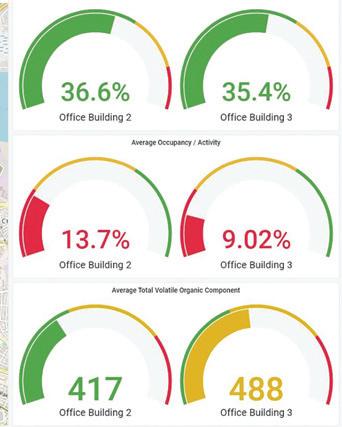
In order to talk about wellbeing, it is necessary to satisfy basic human needs:
• Clean air
• Clean water
• Natural light
• Optimize exposure to noise


• Being a part of the community.
These points are the primary goals of workplace architecture , and they are also called primary comforts. It is essential to fulfill and integrate these points into every space.
Source: NovaVector
According to IWBI WELL standardization (IWBI International WELL Building Institute) in order to experience well-being and achieve the welfare of people and businesses, the following points are equally important:
• Physical activity, movement
• Nutrition
• Materials used in space
• Mental health.
Now that we have an idea about it , we can already create our own image of space well-being , i.e. good WORKPLACE.
Benefits
Our job as consultants is to recognize primary comforts in every space, evaluate their quality and pass the relevant data to the client. Then we can suggest solutions and methods of achieving the optimal comfort level, and later encourage the development of qualities that the company culture and type of workplace demand and promote. Everything that leads to satisfying the primary comforts and needs of people is considered as necessary characteristics of a workspace that everyone should achieve.
92 HR World 09 | April 2023
Source: NovaVector
The well-being experience is trendy, and it relates to SMART, Tech, Agile design solutions, and peoplefirst company culture, but above all, it is a systematically designed, healthy and problemsolving approach to employees through taking care of the spaces they occupy
Only when the functionality of the first five parameters is enabled in cooperation with clients, the world of BENEFITS and of well-being is entered

Only then can we exit the necessary and step into well, focusing on architecture, branding, tech, agile space organization and other solutions that lead us closer to the prime design of the workplace
Experience
The well-being experience is trendy, and it relates to SMART, Tech, Agile design solutions, and people-first company culture, but above all, it is a systematically designed, healthy and problem-solving approach to

PRACTICES WELL-BEING
G E NERGIJ A –The Heart of a Lion and the Art of Good Health!

Generali has been focusing on well-being in different ways for years. In 2019, more than 150 of our colleagues attended the Challenges of workshops, dealing with the challenges of parenthood, and in 2020, over 200 of our colleagues attended the Resilience in the Age of the workshops. Over 80 employees took part in the psychological counseling program over the course of the 2020 lockdown.
GENERGIJA projects, we officially continued to focus on our employees’ work-life balance, integrating a variety of initiatives and activities. We declared the GENERGIJA project a new family-friendly measure because that is another way of showing that our employees’ well-being is our priority.
GENERGIJA project are:
GENERGIJA Day is a day when, in addition to performing the usual professional duties, our employees have a chance to work outdoors and be involved in activities that teach us how to bring balance into our working day and take care of ourselves. We practice yoga, get advice on a healthy diet, have a massage and exercise, have a healthy meal, and learn how to create a work-life balance together.
GENERGIJA Hour consists of webinars held once a month, during which employees receive useful information on a variety of topics related to well-being. Some of the topics we talk about, such as mental health, HPV vaccines, health formulas, and how to avoid products that are potentially harmful to our health, are presented by experts who share numerous guidelines, tips, and tools.
We have made official the practice of dealing with mental health issues through the Psychological Support Program as part of the GENERGIJA project. Today, every employee of the company can ask for psychological support if they face a mental health challenge and they get help from licensed mental health experts.
Manager
We are aware that the well-being of our people doesn’t start or end at work. That's why we strive to encourage everyone to maintain GENERGIJA by adopting new habits, creating a future where employees are satisfied, in good health, and fulfilled, which has a farreaching impact on our results.
GENERGIJA DAY IS A DAY WHEN, IN ADDITION TO PERFORMING THE USUAL PROFESSIONAL DUTIES, OUR EMPLOYEES HAVE A CHANCE TO WORK OUTDOORS AND BE INVOLVED IN ACTIVITIES THAT TEACH US HOW TO BRING BALANCE INTO OUR WORKING DAY AND TAKE CARE OF OURSELVES
April 2023 | HR World 09 95 WELL-BEING | BEST PRACTICES
Jelena Višnjić,
for Compensation & Benefits, Strategic Workforce Planning and HR Analytics, Generali Osiguranje Suzana Banović, Training and Development Manager, Generali Osiguranje
Well-being ProgramsThe Right Thing to Do
Ivana Vlaški, Learning and Development Expert, CETIN
Whether it is from employees’ or employers’ perspective − a sense of well-being surely touches several aspects of working life: meaningful work, development, psychological safety, appreciation, etc. and on top of it − HR leaders must consider additional well-being programs because it’s the right thing to do. Well-being is tightly connected with employees’ experiencewhen they feel aware of their strengths, and readiness to get engaged and progress, which is vital for feeling valued.
96 | HR World 09 | April 2023 WELL-BEING | BEST
PRACTICES
If there is a singular truth in our world, it’s that we are nothing without exceptionally skilled, motivated employees, and ensuring their professional growth and well-being is our top priority. To us, connection is one of the most important tools in our well-being toolkit.
CETIN now employs 310 people, and since it was founded in Serbia in 2020, we have proudly welcomed 69 new colleagues. We practice dialogue with all our employees and see well-being as the perfect platform to strengthen our connectedness, resilience, and exploration. Hearing our employees’ preferences, we reached out to them presenting our well-being initiatives as an opportunity to build up a positive approach towards health – offering them the chance to connect on an extraordinary occasion and get to know each other outside of work. What we learned was that exceptional employee experience is all about connection and authenticity.
AUTHENTIC EXPERIENCES CREATE MEMORIES
When it comes to sports activities, our communication internally changed from: ’’Are you ready to take on the well-being challenge?’’ confirming 15 attendants, to:
‘’We conquered the highest mountain peak in Serbia in the largest group’’, with more than 50 colleagues onboard. Thanks to our first 15 promoters, we didn’t need any more promotion tools or to gather employees and create our well-being calendar.
CETIN adventures are the perfect blend of those experienced and enthusiasts, on both sides, loving to accept the challenge. Hiking was the most loved initiative among employees, and we found out that some colleagues are great connoisseurs of hiking etiquette. We also had those who bought their hiking shoes just yesterday, but were still equally enthusiastic about it. Therefore, we hiked through thick 1m snow, and stayed in the mountain hut, truly unplugged in the midst of jaw-dropping mountain sceneries, equipped with only necessities, enjoying the sounds of wooden floor creaks when you walk on it and nature.
Encouraging individuality, we are proud to say that we built up diversified activities, such as psychology meet-ups, yoga classes, and forming running, football, and volleyball teams. Thoughtful gestures for employees’ important milestones, such as
work jubilee gifts, or gifts for their first graders are also always a lovely addition to strengthening relations with our employees.
CETIN Serbia is a part of CETIN Group, a leading telecommunications infrastructure provider, operating across Central and Eastern Europe and we are masters of connecting people.
STRATEGY April 2023 HR World 09 | 97
WHAT WE LEARNED WAS THAT EXCEPTIONAL EMPLOYEE EXPERIENCE IS ALL ABOUT CONNECTION AND AUTHENTICITY
IF THERE IS A SINGULAR TRUTH IN OUR WORLD, IT’S THAT WE ARE NOTHING WITHOUT EXCEPTIONALLY SKILLED, MOTIVATED EMPLOYEES, AND ENSURING THEIR PROFESSIONAL GROWTH AND WELL-BEING IS OUR TOP PRIORITY
Work-life balance is the key component of success
on our personal development journey.
As his colleagues can firmly confirm –Dragan Krsmanović, Banca Intesa‘s HRO team member with more than 25 years of successful working experience - out of which 18 in the bank - is the best example of how to actually practice and benefit from that kind of work-life approach. To adopt such a lifestyle, according to Dragan, the most important is not to be exclusive and draw a clear line between the two, but rather to find a real harmony and readiness to embrace and intertwine work and private, as this combo is a true enabler of personal and professional growth. Being a multi-experienced team player, Dragan has been successfully
transferring skills and lessons mastered in sports playgrounds to work, and vice versa. Such as the one about the importance of continuous training as a precondition to overcoming all obstacles on the way to your goal, or how the energy, support, and feedback coming from colleagues, could push you beyond your limits and unleash your full potential. With such an attitude and energy, it felt natural for Dragan to initiate the founding of the BIB (Banca Intesa) running team. Since last year, his BIB’s fellow runners from the whole bank have participated in all noteworthy running events in Belgrade.

98 | HR World 09 April 2023 WELL-BEING | BEST
PRACTICES
Finding the right balance in everything we do seems to be everyone’s life goal, yet it can be quite difficult when it comes to career vs private life scale. To succeed and thrive in business, it is crucial to remain committed to all that helps you flourish as an individual, just as we need to rely on our teammates and work challenges as encouragement
It is the satisfaction and fulfillment of individuals that makes a company successful, and for this reason it is necessary to provide additional benefits, such as: gym memberships, private health and Best Doctors insurance, subscription to workout mobile apps, etc.
BANCA INTESA
It is important to utterly understand the significance of health and sports habits for personal well-being, energy and consequently a successful and happy life, therefore, investing in sports activities of employees and their children is crucial
Currently, the BIB’s team is preparing together for the greatest challenge so far: ISBD Running Event! The international sports event, which traditionally brings together the employees of the entire Intesa Sanpaolo Group, is of the biggest spring deals for over 80 BIB runners, who will try to score new team and personal records.
- It is an internal cultural thing. It’s a must to always set more ambitious goals and explore new ways of becoming the best version of yourself. The same thing stands both for business and sport - it is important to raise the ladder. A sense of belonging grows, and successes multiply only if we activate our full capacities, skills, and talents. When a group of people gets together around these values, invincible teams are created – the ones in which we upgrade ourselves from day to day and can push the boundaries together –concludes Dragan.
It is important to utterly understand the significance of health and sports habits for personal well-being and energy and consequently a successful and happy life, therefore, investing in sports activities of employees and their children is crucial.
After the many mountain and city runs and challenges he conquered, the one that he is the most proud of is a recent halfmarathon. It was the first time for one of his younger and far less experienced coworkers and running buddies on that race track, therefore it just came naturally to him to adjust his speed and take a mentor’s role and support her in reaching the goal. “Our team’s energy is our superpower and it gets even stronger when facing the outof-office challenges”, highlights Dragan. Likewise, as he strongly believes, all his running accomplishments would remain unimaginable without the support of his work team members - his role models in business but also best friends for life. This is why he always highlights team cohesion in the bank and the safe and supportive environment that is enabling all its people to prosper.
For example, there are many active BIB sports teams in Banca Intesa - basketball, football, and volleyball - that have traditionally participated in and won local business and international league tournaments organized on the level of the Intesa Sanpaolo banking group. Similarly, children have the opportunity to participate in a 2-week summer sports camp in Italy, and other events, out of which the biggest deal is the Intesa Junior Olympics.
Balance between work and private life is of crucial importance for the well-being of an individual. It is the satisfaction and fulfillment of individuals that makes a company successful, and for this reason it is necessary to provide additional benefits, such as: gym memberships, private health and Best Doctors insurance, subscription to workout mobile apps, etc. Continuous improvement of already established wellbeing benefits and programs is set as an unwavering resolution at Banca Intesa in order to support all team members in developing healthier habits and finding the inner balance.

Name one good practice you implemented to improve employee engagement
Good lifestyle choices!
Employee well-being is in focus at Addiko Bank Podgorica!
Our goal is to help employees thrive through an active lifestyle, to improve their health and fitness levels, increase their energy and productivity and lower their healthcare spending.
We are encouraging good lifestyle choices to help employee wellbeing and support them by providing subsidized gym memberships as a benefit.
Based on data analytics - not all employees use gym, therefore we consider some gym alternatives as well. We are offering our staff other ways to exercise - to choose other physical activities that better suit their lifestyle - tennis, football, basketball, swimming, etc.
This year, we will extend membership to an area of local beauty to encourage walking and enjoying the great outdoors, since not everyone likes sports or exercising.
In conclusion, the healthy lifestyle alternatives are more beneficial when it comes to the overall health and well-being of the employees.
Jelena Đuranović, Human Resources & Corporate Communications, Project & Process Management Director, Addiko bank AD Podgorica
Culture bonds us together
If nourished properly, corporate culture could be one of the strongest advantages of each company, making a difference between inspiring and toxic workplaces.
With the brand change, One Montenegro had to introduce a new culture. It was a great opportunity to include employees in making new values alive.
We invited everyone to participate in the competition by illustrating the new values. Employees shared a photo, video, story, or any other form they found illustrative. Each entry was published on our internal hub, and everyone could vote for their favorite suggestion. The winning team was awarded a joint activity.
The election of culture ambassadors was next on the list. The entire company voted and selected seven culture ambassadors who who will further promote the new values.
These days, ambassadors are talking about the culture with the new employees over a cup of coffee.
With new activities coming up, we continue to co-create an encouraging workplace with our employees!
Biljana Radusinović, HR Director, One Montenegro
100 HR World 09 | April 2023 BEST PRACTICES
GET READY TO DISRUPT THE HR INDUSTRY! DISRUPT HR BELGRADE I JUST & LOBBY SPACE I 14TH SEP 2023 GET A TICKET hrworld.org/disrupt-hr/
As part of the "Flower of Success for the Dragon Woman" event, the title of the "Most Gender Sensitive Company" as in the last five years, has been given out to organizations with noteworthy practices. All three awarded companies are also the members of HR World, and we are sharing their amazing stories.
gender equality

Schneider Electric
Companies today have an extraordinary responsibility in terms of creating a work environment that is tailored to their employees. For this purpose, companies introduce a whole range of benefits to raise their competitiveness in the market and to attract quality personnel. This is also a demanding task because the company must recognize the needs of the employees and then successfully include them in its well-being programs, otherwise, a gap between what the company offers and what the employees need will be significant.
Compared to the earlier period, when well-being meant a set of benefitsequal for all employees, today there are also those companies that recognized the need for benefits which include programs created in relation to the individual needs of employees.
This is a result of a growing trend among employees who aim to choose benefits they need for themselves. This represents a kind of enhancement of the concept and moving forward in line with employee needs, with the same goal – to have satisfied employees.
In a wider context, well-being also includes ethical and responsible business operations, respect for people and their human rights, positive environmental impact, and naturally, gender equality.
In Schneider Electric, nearly 40% of women are in
April 2023 HR World 09 | 103 DEI | BEST PRACTICES gender
IF COMPANIES AIM TO MAKE BENEFITS RELEVANT FOR EMPLOYEES, THEY NEED TO FOLLOW TRENDS AMONG THEIR EMPLOYEES AND RESPOND TO ONGOING NEEDS
managerial positions, whereas female employees exceed 35% of the total workforce.
Our company supports and develops well-being initiatives in several manners:
Empowering women in STEM and empowering girls to choose STEM professions – Last year, we participated in AFA Hackathons for female university or secondary school students interested in meeting female mentors from tech companies and in developing solutions that would help resolve technological challenges.
Supporting the Girls’ Day in the ICT sector – For several years now, we have been organizing panels for girls
related to career development in IT. Support for girls is also recognized via Schneider’s “Young Talent Centre” Foundation, where girls are encouraged to select tech and IT professions. With this Foundation, we provide free maths and programming lessons to pupils all over Serbia.
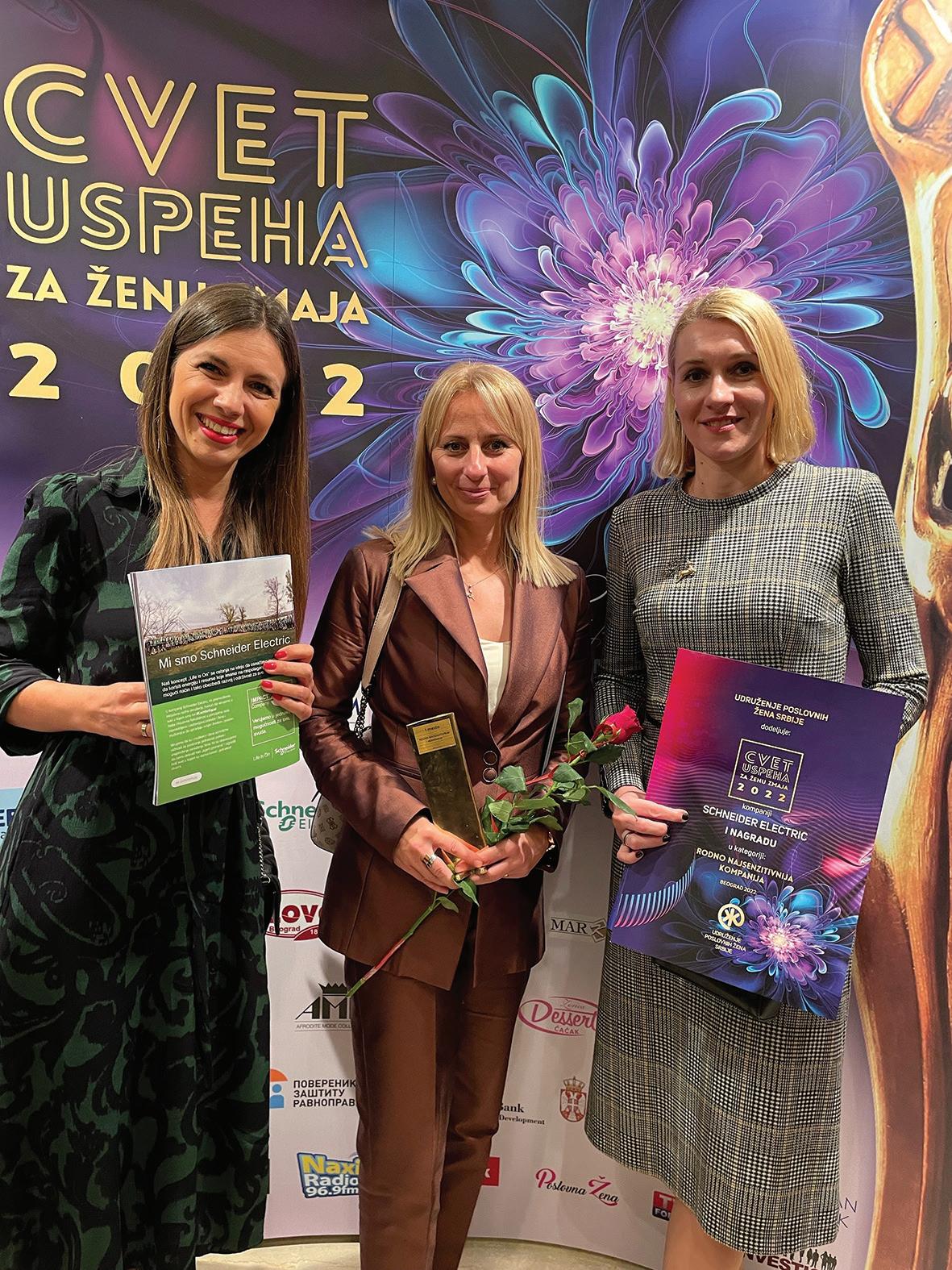
In cooperation with the Faculty of Electrical Engineering in Belgrade, panel discussions themed “Female engineers in business” have been organized, where female university students have had an opportunity to hear firsthand what it is like to work in a corporation and what challenges and obstacles a female engineer meets when launching her career. Also, the company’s internship programme presented to female students has raised strong interest among many of them.
If companies aim to make benefits relevant for employees, they need to follow trends among their employees and respond to ongoing needs. In that respect, Schneider Electric has recognized the need to ensure conditions that will provide employees with the opportunity to achieve better work/life balance and introduce a range of benefits to support it:
From the Summer Recharge (working Fridays shorter by 4 hours in summer), to the
budget for training, where an employee individually decides which educational course to take, to the Step Up platform, that enables employees to recognize and reward a colleague or a team, with an option of converting points collected in this manner into a voucher or a day off at a specific moment, or the Flexible Benefit Platform (a unique platform enabling individual approach to benefits, where employees choose a benefit that suits them best), to WESOP [the Worldwide Employee Share Ownership Plan], a programme enabling employees to participate in purchasing the company’s shares.
The benefits also include well-being educational courses and an option of free psychological support to employees in need, as well as financial or legal consultations
104 | HR World 09 April 2023 DEI | BEST PRACTICES
WELL-BEING ALSO INCLUDES ETHICAL AND RESPONSIBLE BUSINESS OPERATIONS, RESPECT FOR PEOPLE AND THEIR HUMAN RIGHTS, POSITIVE ENVIRONMENTAL IMPACT, AND NATURALLY, GENDER EQUALITY
THE BENEFITS ALSO INCLUDE WELL-BEING EDUCATIONAL COURSES AND AN OPTION OF FREE PSYCHOLOGICAL SUPPORT TO EMPLOYEES IN NEED, AS WELL AS FINANCIAL OR LEGAL CONSULTATIONS
Erste Bank
In Serbia, the banking and finance sector employs more women, but if we look at the managerial structure, there are still more men among managers, especially in higher management positions. This is exactly where the space and potential for positive changes lies.
WHERE DO WE STAND?
Erste Group has recognized diversity and inclusion as an important part of its longterm business strategy, and gender equality is one of the pillars of its business. We are committed to proactively implementing a number of initiatives to support the development of female leadership through our employment and development policies, and from 2023 all banks in our Group will have their own local diversity and inclusion managers.
Across the Group, more than 60% of employees are women, and over 25% are women in top management positions. In Serbia, we employ over 70% of women, who occupy almost 52% of management positions at all levels. Since last year, within the Group, we have had two female CEOs, in Austria and in Serbia.
SHE INVESTS – ONE OF OUR INITIATIVES
For two years in a row, Erste Group has been implementing an internal project –She Invests. It is an initiative that aims to connect women – colleagues from all seven countries in which the Group operates, in order for them to exchange
So far, Erste Bank has received two recognitions for its activities in the field of gender equality and women's empowerment: Special recognition for the strategic development of female managers (2021) and second place as the most gender-sensitive company in Serbia (2022) awarded by the Association of Businesswomen of Serbia.
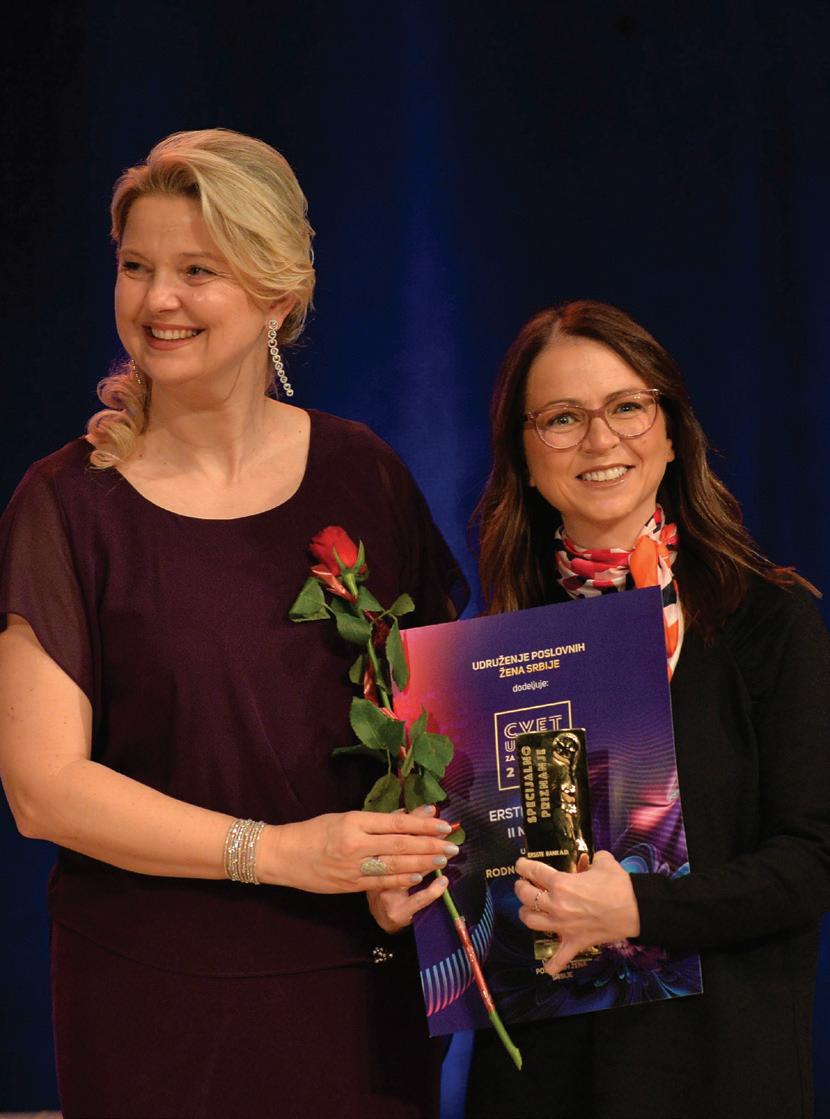
knowledge, experience, and everyday challenges from a female point of view. So far, two large conferences have been held, having gathered thousands of employees, and providing a platform for them to talk, learn and open some new chapters on the topic of finance and business from the female perspective. We talked about how to invest in ourselves and develop our potential, how difficult it is in these challenging times full of uncertainty, and even fear, to be a woman, mother, wife, successful manager. There were two parts to each conference: the first, which was the same for all participants, in which international inspirational speakers addressed the real situations from our everyday life, and the second, completely focused on local challenges and current topics of each country. Through a live and interactive panel discussion, they talked about problems, solutions and techniques for empowering women and their mental and financial health. The feedback and extremely positive impressions of the participants encouraged the team, which is already working on the preparation of the next conference traditionally held in October.
DEI – FUTURE POTENTIAL
We are aware that DEI is something that must be nurtured, and we will continue to invest in it, doing our best to utilize its highest potential, because only companies that recognize and strategically integrate the principles of diversity and inclusion have a chance to survive and develop faster, with satisfied employees.
LIE
April 2023 HR World 09 | 105 DEI | BEST PRACTICES
THE BANKING AND FINANCE SECTOR EMPLOY MORE WOMEN, BUT IF WE LOOK AT THE MANAGERIAL STRUCTURE, THERE ARE STILL MORE MEN AMONG MANAGERS, ESPECIALLY IN HIGHER MANAGEMENT POSITIONS. THIS IS EXACTLY WHERE THE SPACE AND POTENTIAL FOR POSITIVE CHANGES
Inclusion and respect for diversity are at the very top of the values that Nestlé stands for. Improving gender balance is leading to better decisions, stronger innovation and higher employee satisfaction. Our goal is to provide a workplace culture that creates equal opportunities for everyone and where employees are treated with dignity and mutual respect.
Numerous local and global initiatives are evidence of this:
• Ensuring gender equality of employees in managerial positions, with monitoring of certain KPIs
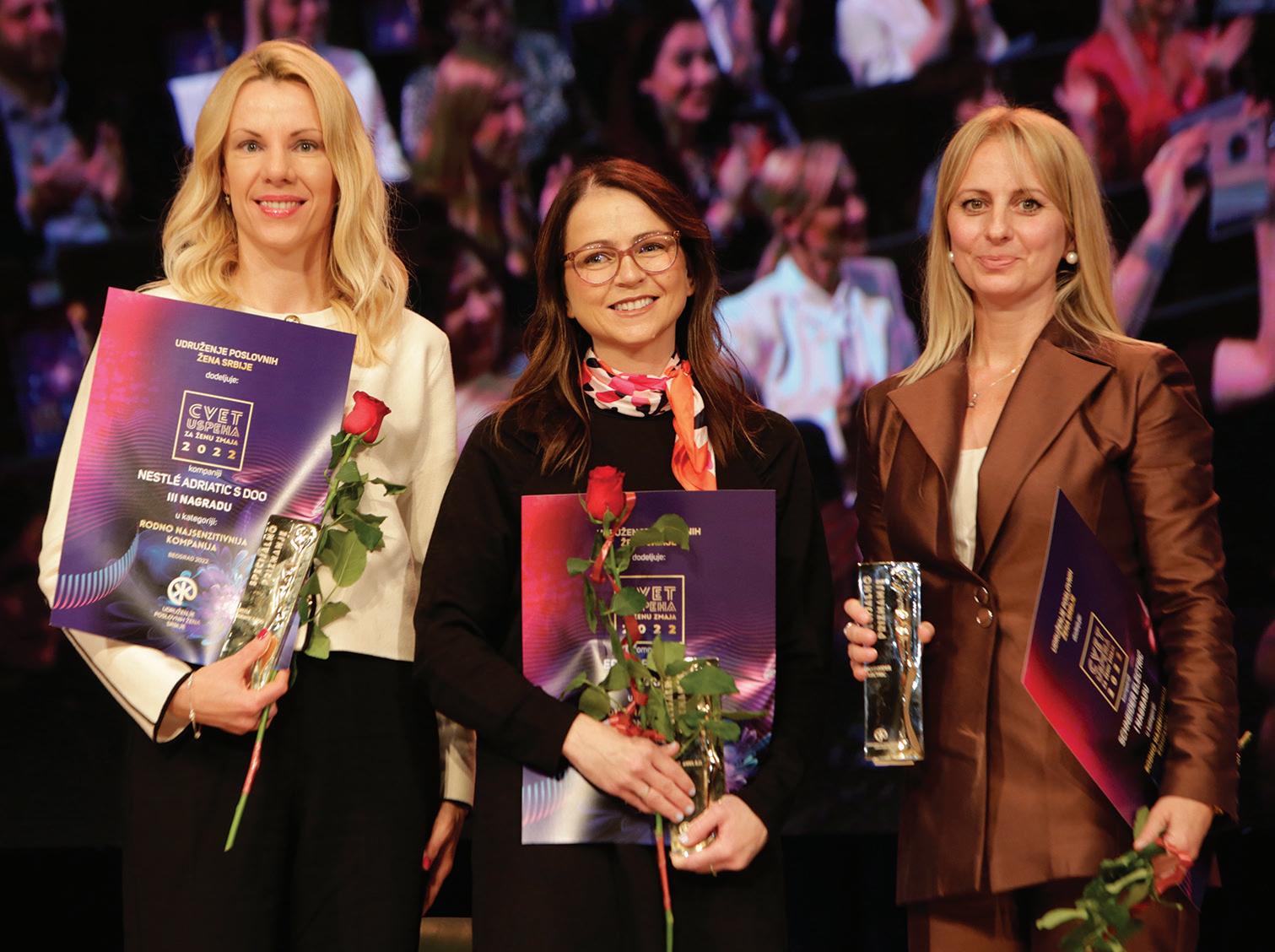
• Creation of numerous development opportunities through mentoring and coaching programs
• A flexible work environment with the possibility of hybrid work - from home and from the office
• Leadership development training and workshops dedicated to combating unconscious bias, as well as education for all employees on the topic of accepting and supporting diversity
• Developing and perfecting the Policy for supporting parents, with a special emphasis on ensuring gender neutrality. This Policy includes the provision of supplementary food for the babies of our employees if they need it, breastfeeding rooms, ensuring the same level of income for those on maternity leave for the first 18 weeks of leave, as well as 4 weeks of paid leave for employees who have become parents.
YOU CAN MONITOR THE SOCALLED GENDER PAY GAP, THAT IS, DETERMINE WHETHER THERE IS A "GAP" BETWEEN SALARIES, BY COMPARING THE AVERAGE SALARY OF ALL MALE EMPLOYEES IN THE COMPANY WITH THE AVERAGE SALARY OF FEMALE EMPLOYEES AT THE LEVEL OF THE ENTIRE COMPANY
106 | HR World 09 April 2023 DEI | BEST PRACTICES
Nestlé
How can YOUR company be more gender sensitive? Here are 3 initiatives that we use at Nestlé that you can think about:
1You can implement a project called Equal pay, which involves comparing the salaries of men and women in the same positions, and in this way, you can monitor whether there are differences in salaries and define additional steps. The main goal of monitoring the Equal Pay coefficient is to establish gender equality in terms of income, according to global standards.
2
You can monitor the so-called Gender Pay Gap, that is, determine whether there is a "gap" between salaries by comparing the average salary of all male employees in the company with the average salary of female employees at the level of the entire company, all with the aim of completely eliminating the difference in earnings between men and women.
3
Do you encourage an increase in the number of women in leading positions? Nestlé is an environment that encourages this within the Gender Balance Acceleration Plan, so in top management, which includes the highest management positions in Serbia, we have 83 percent of women, while the participation of women in managerial positions is as high as 60%.
Creating an inclusive environment is crucial for companies to ensure that all employees feel valued and respected. To make a more inclusive environment, companies can take several steps such as providing diversity and inclusion training for all employees, creating a diverse recruitment strategy, establishing clear policies and procedures for addressing bias and discrimination, promoting diversity in leadership positions, and providing flexibility and accommodations for employees with different needs. Companies can also hold regular diversity and inclusion discussions, celebrate cultural events, and support employee resource groups to promote a sense of belonging and community.
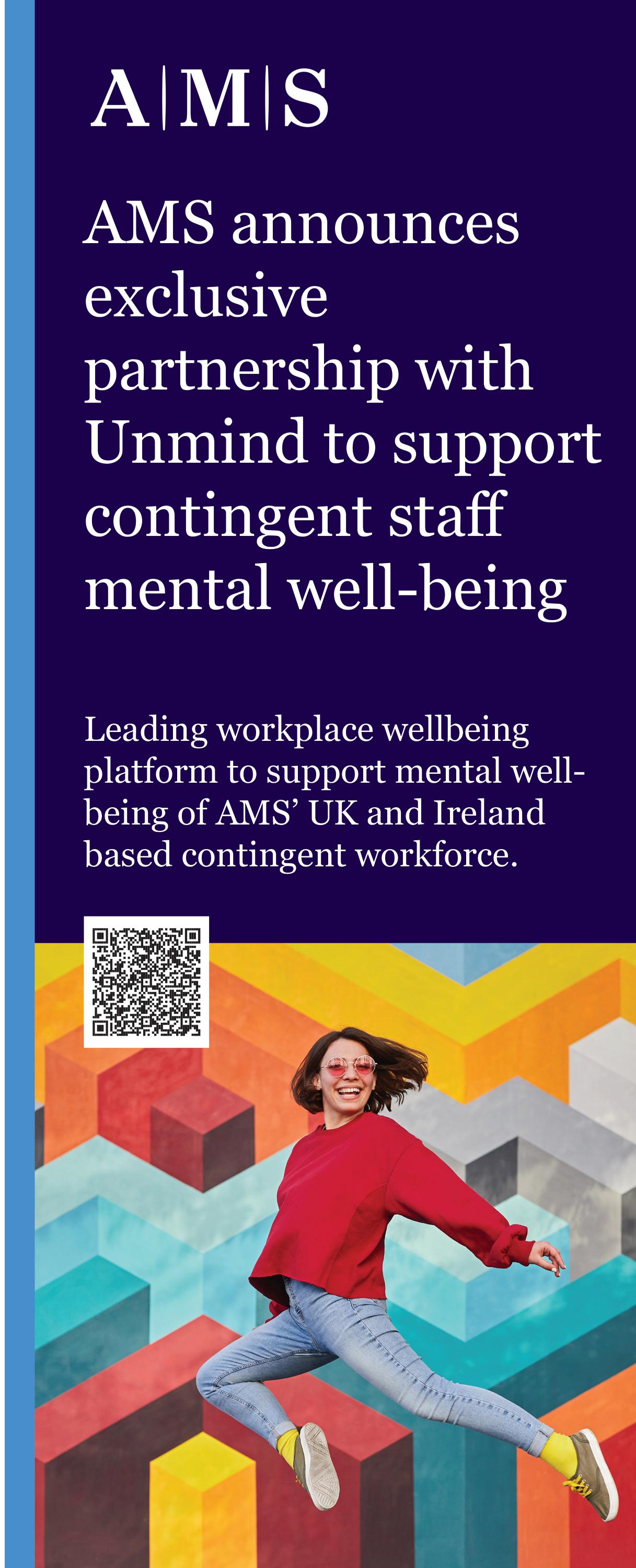
CREATING AN INCLUSIVE ENVIRONMENT IS CRUCIAL FOR COMPANIES TO ENSURE THAT ALL EMPLOYEES FEEL VALUED AND RESPECTED
Authors
Nenad Mijailović
Dr. Wieby Altink
Wieby Altink is an organizational psychologist, registered with NIP & Europsy. Her passion is to support people and organizations to work together so they achieve their goals. She had the role of managing consultant in international work context, advising organizations in Leadership, strategic HR, Executive Assessment, and Coaching for 25 years. Before that, she worked as an associate professor at the University of Amsterdam, and member of the research school on Work and Organizational Psychology, for about 10 years. Currently, she is involved in lecturing and supervising master students at Utrecht University and Athena VU.
Slobodanka Cvetković
Slobodanka Cvetkovic, PhD in Industrial and Organizational Psychology. Senior People & Culture professional with more than 17 years of experience in Philip Morris Srbija. Currently holding a Talent Management role specified in Executives Succession Management. Certified Erickson ICF Coach. A true believer of the synergy between growth and motivation will always be a key for achieving dreams.
Charlotte Lockhard
A business advocate, investor, and philanthropist with more than 25 years of experience in multiple industries locally and overseas. As founder and managing director for the 4 Day Week Global campaign, she works to promote internationally the benefits of a productivityfocused and reduced-hour workplace. Through this, she is on the board of the Wellbeing Research Centre at Oxford University and the advisory boards of the US campaign and the Ireland campaign for the 4-day week. Since a diagnosis with Stage 4 breast cancer, Charlotte has become very focused on changing the way we work today to a better, more inclusive experience for everyone.


Suzana Đorđević


Suzana Đorđević has been the Director of Hemofarm Foundation since April 2015. In the past eight years, the socially responsible campaigns and activities she led received more than 40 awards in the country, region and abroad, while in the year 2017, Hemofarm Foundation was declared the leading foundation in Serbia.
MsCF, CFA, ACCA
Nenad has been working for Galenika a.d., a pharmaceutical producer from Serbia, as a CFO since 2018. Prior to that, Nenad spent 10 years working for the Government of the Republic of Serbia as a state secretary in the Ministries of Finance and Economy. He also worked for JP Morgan London, AVS Pension fund, Geneva, and Deloitte, Belgrade, where he started his professional career 20 years ago. Nenad is a CFA and ACCA charter holder, and an Alumnus of both HEC, the University of Lausanne (graduate studies), and the University of Belgrade (undergrad studies). Nenad is a PhD student. candidate and father of three children.

108 HR World 09 | April 2023 AUTHORS
Tom Haak
Tom Haak is the founder of the HR Trend Institute.
The HR Trend Institute follows, detects, and encourages trends, in the people and organization domain and related areas. Where possible, the institute is also a trendsetter. Since the beginning of 2020, he has been a distinguished visiting professor at Tecnológico de Monterrey, one of the leading business schools in Mexico. Tom is considered to be one of the leading global HR thought leaders.
Dennis Kaminsky
Dennis Kaminsky, Ph.D. Partner and founder of FutureToday – the leading Employer Branding and graduate recruitment company in Russia. The client list includes top global consulting companies, retail, FMCG, metals & mining, and financial companies.



FutureToday’s assets include a leading graduate recruitment website www. fut.ru, the Best Russian Employers Award, and a score of career fairs in major Russian cities. In 20202021 Dennis has been a co-chair of OneAgent – a leading global network of EB agencies. Besides running a business, Dennis teaches marketing and EB at Lomonosov Moscow State University and Universal University.
Vesna Laković Van Kempen
Vesna has been making programs and education that fit the needs of today for the past 13 years. She leads personal and professional development training in approaches based on the practice of Mindfulness at universities and organizations for a variety of groups and ages. She works hard to make people curious and aware while providing the best learning experiences possible through her workshops, online courses, and blogs. Nowadays, André and Vesna van Kempen lead Bujoo Education, with their main focus on bringing Mental Fitness to organizations in the Balkans and Europe.
André is a lifelong entrepreneur who excels at creative problem-solving. He founded his first company at age 20, but his success came at a high price. Burnout and substance abuse profoundly impacted his life and wellbeing. From his own struggles, he learned how important it is to be resilient and stay in the present moment. Now he’s on a mission to share his knowledge and prevent others from experiencing the same pain in the business world.
Nowadays, André and Vesna van Kempen lead Bujoo Education, with their main focus on bringing Mental Fitness to organizations in the Balkans and Europe.

Stefano is an Associate Professor at the University of Strasbourg. He is the Director of the Chair “Data Science for Economics and Business”, Fondation Université de Strasbourg (supported by Crédit Agricole and Mazars). His research interests include the economics of science and innovation, micro-econometric modeling, and applied machine learning. He is a member of expert groups for the European Commission (DGJRC-Modelling, Indicators and Impact Evaluation) and OECD (Structural Policy Analysis Division, Economics Department) and consults for private sector organizations in the area of data analytics. He was awarded the “Guy Ourisson Prize 2020” (Gutenberg Circle).

April 2023 HR World 09 | 109 AUTHORS
André Van Kempen
Dr. Stefano Bianchini
Tijana Bejatović
Tijana is a passionate enthusiast of internal communications. She strongly believes that how we communicate at work has the power to transform our individual lives, and the companies we work for. This is why she founded “topIC,” a platform dedicated to building and strengthening the field of internal communications in the Balkan market.

As a strategist, consultant, and trainer, with over 15 years of experience in both corporate and service environments, she is committed to improving the way organizations communicate with their employees and elevating the internal communication function to meet the everevolving needs of businesses.


Steve is the co-founder of Wonder, an employee experience design company based in Stockholm. As a passionate advocate of the power of experiences and design thinking practitioner, he spends his time designing unique experiences that engage people and differentiate in a competitive talent market.

Alex Hirst & Lizzie Penny
Lizzie and Alex are friends, entrepreneurs, inspiring speakers, and changemakers. Together they came up with the concept of workstyle, to refresh the world of work and change it for the better, in response to their negative experiences of a 9–5 traditional working week. They have been leading the workstyle revolution for a decade, founding a social enterprise, Hoxby, to prove the concept. They have helped thousands of workstylers around the world to set, project, and respect their own workstyles, and are conducting pioneering research into the link between autonomy, productivity, and well-being. Their business has delivered projects in a workstyle way for some of the biggest brands in the world.
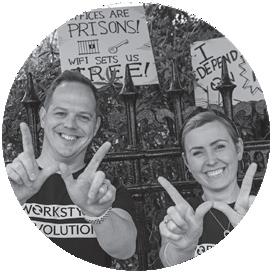
Milana Malešev
Milana Malešev, PhD A CIPD Qualifications
Tutor, Founder of Learning Makeover, and an Associate Professor of Social and Organizational Psychology at FEFA.
Milana developed her consulting skills and business acumen working as a PwC client facing professional for 14 years. In 2020 she obtained a PhD in Psychology, in learning in the workplace. Years of simultaneous professional and academic work brought great enrichment in both fields. Milana enjoys sharing her insights with clients and students, helping them rethink their approach to people development.
Milica Helmih
Milica Helmih is a graduated Psychologist, currently pursuing her Master’s studies in Social Health and Organizational Psychology at Utrecht University and working as Learning & People Development Intern at Heineken Company in Amsterdam. During her bachelor studies, she was involved in many extracurricular activities as a President of the Student Club with the goal to promote different topics in Psychology. Her interests include mental health, and well-being of employees as well as coaching and psychotherapy. Milica is currently researching connections between workload and well-being as main variables in her Master’s thesis.
110 | HR World 09 April 2023 AUTHORS
Steve Usher
Nebojša Bjelotomić
Nebojša graduated from Boston University in the field of biomedical engineering. His career started in an American biotech startup, but soon, upon his return to Serbia, he joined IBM, then Fujitsu Siemens where he very soon reached a leadership position for the entire region. During that time, he continued his education with a Master's degree in management and marketing, and became the CEO of Printec. He had spent five years as the CEO of Saga. He has been actively supporting Serbian startup teams in their efforts to expand globally. Since October 2021, he has been leading the work of the nongovernmental and non-profit organization Digital Serbia Initiative.
Konstantina Marsenić
Konstantina Marsenić is a design architect and founder of the Konstantina Marsenic Studio, with 20 years of experience in design, construction management, and project supervision. Wishing to expand her competencies in adding value to a wider community through architecture and design, she recently developed a new brand within her studioWork Well, which aims to gather professionals in different fields - architecture and related professions, IT, HR, Branding, PM, etc, in order to implement diverse and specific knowledge into contemporary concepts of working, private and public spaces.
Višnjić
Jelena Višnjić Manager for Compensation & Benefits, Strategic Workforce Planning and HR Analytics, Generali Insurance Serbia, Bachelor degree in Economics, Senior Professional with 15+ years experience in the HR field.


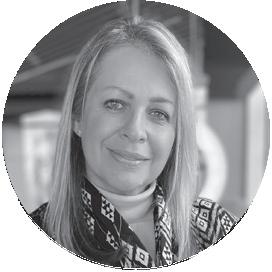
Suzana Banović
Suzana Banović works as a Training and Development Manager at Generali Osiguranje Srbija. As a psychologist and psychotherapist, she has twenty years of experience working with people on their well-being through training, coaching, and psychotherapy.

Having a degree in Philology, I started my career stepping into the communications and advertising sector and collected six years of experience in providing creative support in the realization of internal and external communication strategies. Following my transition to HR in the L&D role, this background helped me a lot to execute employer branding activities and take care of the most beautiful part of HR, now collaborating with unmatched professionals in CETIN Serbia, while together championing learning culture. It is genuinely exciting to create learning solutions and partner up with innovative vendors to provide my colleagues with the best resources to grow personally and professionally, while they are at the frontline of telecommunication network modernization.
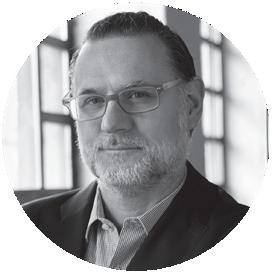
April 2023 | HR World 09 111 AUTHORS
Jelena
Ivana Vlaški




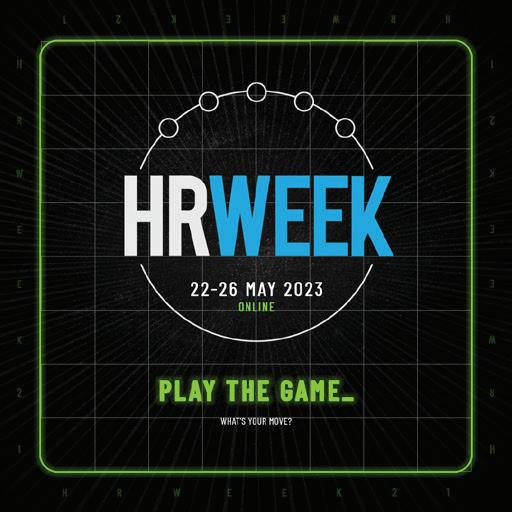






GET PREMIUM ACCESS! VISIT www.hrweek.global 2019 2020 2021 2022






































































































































